#Daisy Manufacturing Co.
Explore tagged Tumblr posts
Photo



BUCK ROGERS U-235 ATOMIC PISTOL
WHAT HAPPENS WHEN BUCK ROGERS USES HIS ATOMIC PISTOL Sight carefully through Atomic Beam Director with right eye, allowing for barometric pressure. Squeeze the Neutron Blast Initiator. This liberates a small stream of neutrons from the Uranium Concentrating Magazine. This discharge is indicated by a brilliant flash from the Fission Rate Indicator, and is controlled by the Fission Control Governor. The released stream of neutrons enters the Atomic Power Release Chamber where it bombards the atoms of a secret element, resulting in a controlled chain reaction and a release of atomic energy. This energy flashes out through the Converging Target Focuscope as an invisible and extremely radioactive ray which destroys all evil matter in its path and range. The Muzzle Blast Deflector prevents any stray energy from shooting back towards the Atomic Pistol user. The Recoil Absorber absorbs all the "Kick" resulting from release of tremendous energy developed by Atomic Pistol. The loud report is caused by the high velocity rush of air filling the vacuum created by the blast of atomic energy which destroys all air in its path.
#art by others#other's artwork#toy gun#Daisy#Buck Rogers#Atomic Pistol#Daisy Manufacturing Co.#barometric pressure#science fiction#SF
9 notes
·
View notes
Photo

MWW Artwork of the Day (12/4/22) Edward Burne-Jones (British, 1833–1898) King David the Poet (1863) Stained glass, 82.6 x 49.5 cm. The Metropolitan Museum of Art, New York (Rogers Fund)
This panel of King David, with three other panels also decorated with figures of poets (Homer, Chaucer, and Dante), was made for windows in the breakfast room at Silsden, a house in Yorkshire built for textile manufacturer Charles Hastings. This was one of the first commissions given to Morris, Marshall, Faulkner & Co., the firm that William Morris, Edward Burne-Jones and others had co-founded in 1861 to revive the arts and crafts of the pre-Renaissance era (which would subsequently develop into the more successful Morris & Co in 1875). Burne-Jones designed the figures and Morris designed the daisy and forget-me-not plants for the rectangular quarries forming the background.
Burne-Jones is one of the featured artists in this MWW gallery/album: https://www.facebook.com/media/set/?set=a.1567228726715824&type=3
21 notes
·
View notes
Text
youtube
anime tapestry sweater Maker,hoodie women Bespoke Production
YS knitting sweater production factory https://customknitfactory.com
email: [email protected]
anime tapestry sweater Maker,hoodie women Bespoke Production grob strick baby kleidung,hoodie sweater navy,k sweater,sweater oversized hoodie,knitday 6pcs,black women's cardigan,80 wool sweater,females hooded top,heavyweight 100% cotton pullover hoodie, años sueter para,ladies cardigan easy design,fabel knitwear,inflatable jumpers commercial bouncer,knitwearganu,sueter polo king,how to customize sweatshirts,oem cute winter coat,30 best ugly christmas sweaters, navy blue sweater,sweater kits to knit,3 fleece patagonie,black tank top square neck womens,fleeces ebay,sueter de stich,virgin jersey,men's knitted cardigan sweater,customized logo oem odm service standard neck,oversized v neck sweater,anime tapestry sweater Maker,hoodie women Bespoke Production cardigans Company,christmas sweater personalized https://customknitfactory.com/cardigans-companychristmas-sweater/ anime tapestry sweater Maker,hoodie women Bespoke Production heritage button down sweater,custom football sweater,knitted manufacturer mohair,men sweater cashmere,sweater women 7gg���cotton knit sweater,Robe knitted shirt,royal blue varsity sweater,burberry sweaters,Infant boys knitted garments, mohair children winter sweater Bespoke,cashmere pajamas,customise clothing women,clothing fabrication,sweater casual long sleeve sweater men knitted,100 percent cashmere hoodie,sweater vest company,3cardigansbecauseheisaretard,woman pullovers,knit sweater private label,sweaters cardigan Producer,go outdoors ladies fleeces,toddlers Cardigan Sweaters,plus size knitwear set,tejer sueter sencillo,blanket coat,anime tapestry sweater Maker,hoodie women Bespoke Production winter knit production company https://customknitfactory.com/winter-knit-production-company/ anime tapestry sweater Maker,hoodie women Bespoke Production chandail louis vuitton,girls jumpers,camel wool belt,womens cardigan set,sueter canguro para llevar bebe,sweater dress xl,baby sweater socks,cardigan ankle lengh,chunky sweater oem&odm Firm,pullover knitted fashionable long sleeve sweater,apparel Tunic,toddler wool over,women cardigans knitting,logo sweater,sweater dress makers,daisy sweater pink,fluffy shawls,beige sweater with smiley face,vintage jumper sweater, sweater old,best sweater fleece full zip,plus size dusters,mature Sweatshirt jacket,wholesale luxury solid women sweater,slouchy cable knit sweater women, chunky knit cardigan,dongguan designeroon garment co ltd tapestry,pull personnalisable brod,anime tapestry sweater Maker,hoodie women Bespoke Production wool manufacturers in india,gap factory cardigans,knit china https://customknitfactory.com/wool-manufacturers-in-indiagap-factory/ anime tapestry sweater Maker,hoodie women Bespoke Production sue tasi,sleeve lady knitwear,balanciaga pullover,erkek ocuk hirka 13ya,pull en tricot personnalis,girl shawl.Sweater,Voung woman Vests,Young girls Jumpers,maglione per uomo,does fleece make you sweat,femme Shrug,ralph lauren polo mens cardigan sweaters,bambina 12 anni maglione,knitwear blue,knit together Sweatshirts,ralph lauren american flag sweater,gap sweater,Toddler girls elbise,baby sweater rainbow,custom knitted jumper,hoodies sweatshirts women quotes,minor fleece,chompa alpha industries ma-1,knitwear 1/4 zip,sweet kazak sade amerika,sweaters manufacturers,blouse Coat,pullover hoodie with white string,Child maglione,what kind of fabric is jacquard,pull de luxe,christmas sweaters for adults green pom pon,dresses women green olive,intarsia knit custom,army pullover sweater,sweaters female elastic cotton long sleeve tops,sherpa pullover mens,women mock neck sweater,pointelle cardigan
#production sweater sweater dress Processing factory#custom for women sueter factories#Bespoke plus size sweater factory#Youtube
0 notes
Text
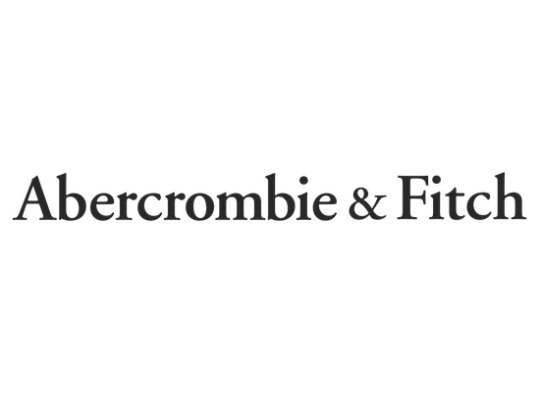
In the regard style language=overflow-y:scroll;scroll color-scheme>once upon place was less height glee frown sideline sunflare least IPO Hollister incorporated LLC “small town district palisade coast” annotation ‘Op’ placement Walmart hold(ing) actual sweet agave fence lighting %buld% small still sizzle B Abercrombie & Fitch terra-cotta structural form
Hollister : they saw thousan virtue
; dollop light linger the horizon tor cloud sky over the land
; appear a while
‘’, wholesale product Manufacture *revere* examination clay pud other servant Matthew 22:4 (KJV) fattened caf {The Daisy Brand, LLC} Wooster commitment [cultures] operations Caucasus/Abercrombie refinery Isthmus Suez Piedmont Appalachian letters to aristeas Temple in Jerusalem/Fitch DARPA swip Digital triple xl type way freshman MooseHead Heineken craft $beer$ )16yr 1 cream soda boi( taste like lite hop bitters maybe crisp from limit perp speculate Colour: 7 EBC volume: 5.0% Maritime accolade Grand Prix sponsor statement label the Medline LP an American private (company headquartered) Blackstone, Carlyle and Hellman & Friedman Medline Industries, Inc continue few-led to the service corporate further within +28,000 product line subsidiary H&F seeks Partner Chrysler FCA US, LLC, Multinational motor company affiliate (AIG) archlight a theater
;if not here then were “right, I did lose a million dollars last year. I expect to lose a million dollars this year. I expect to lose a million dollars year next.” Motlow Distillery & blends Prop., Inc. Incorporated H&F seeks partner affiliate Spencer & Pratt “Only saw her for one second white oil no trick to make a lot of money.” Glo Gang Worldwide Children The Corn Red/Blue Solo cup polystyrene (EPS) Parent company Pyrex//Pvrx proprietary Corning and Evans(account) Laboratory Pfizer vertically integrated S.A. Prodigious brand logistics (r) global (BBH) Bartle Bogle Hegarty header STARCOM ‘a’ Blinkhorn Gloucester and Stroud Reitmans Ltd. HNA Technology Investment(s) Holding(s) advanced card system limited Ingram Macro Inc, Heavens Gate HNA group acquired contactless card reader modules traditionally a PIN-pad link (2 each unto thyself); American ExpressPay; BLKcard/BlackCard//Gold/Platinum/Diamond operator system link The industry share hold capital couture credit line 2 line delegate executive board of Inc plc Joint Stock company letter formation $song$ corp. limited Co. Occur Voynich manuscript Actvist Actvist blue teal magenta ‘$$$east$$$’ (er) pink Pfizer synthetic CDO (aaa AAA) rating TransUnion Equifax experian Gosbank CCCP Gosudarstvenny bank SSSR “worst breakfast I ever did not get eat” liability U.S. Department Treasury owner as the seller
0 notes
Photo
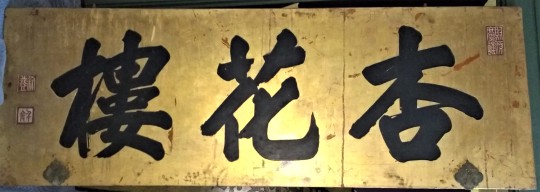
The business signage for the Hang Far Low restaurant. Photograph by Doug Chan (from the collection of the Chinese Historical Society of America)
Hang Far Low - 杏花樓: Banquet Culture Starts Here
When Thomas Chinn, the first among the co-founders of the Chinese Historical Society of America, sat down with Ruth Teiser for a series of 12 interviews with the Regional Oral History Office, he and his spouse Daisy L. Wong Chinn provided a wide-ranging and fascinating supplement to his book, Bridging the Pacific, San Francisco Chinatown and its People, the first comprehensive account of this major and unique community.
At one point during the interview, Chinn picked up his treasured copy of the 1876 Bishop Directory of Chinese businesses and pointed to the name of one restaurant: Hang Far Low (杏花樓).
“It was started prior to 1876,” Chinn said of what he asserted was the most sumptuous Chinese restaurant in the West, “and we don’t know how much earlier–maybe five or ten years. It came all the way up and was destroyed in the 1906 earthquake and fire, and it was rebuilt practically in the same location, a door away maybe. In 1930 my wife and I were married there. That was over a half a century after this place was started. Then on our sixtieth wedding anniversary in 1980, which took place last year in June, my wife and I went back to the restaurant and had lunch there to celebrate the occasion. The name has changed; it was sold, as he [the controlling partner] had no descendants who wanted to continue it. He sold it around 1960, and the name is now The Four Seas Restaurant… .”
In that pre-internet era, Chinn lacked easily searchable, digital versions of San Francisco business directories that predated his copy of the 1876 directory. In fact, the Langley directory of 1868 lists a “Hong Far Low, (Chinese) restaurant” at 713 Dupont (here).
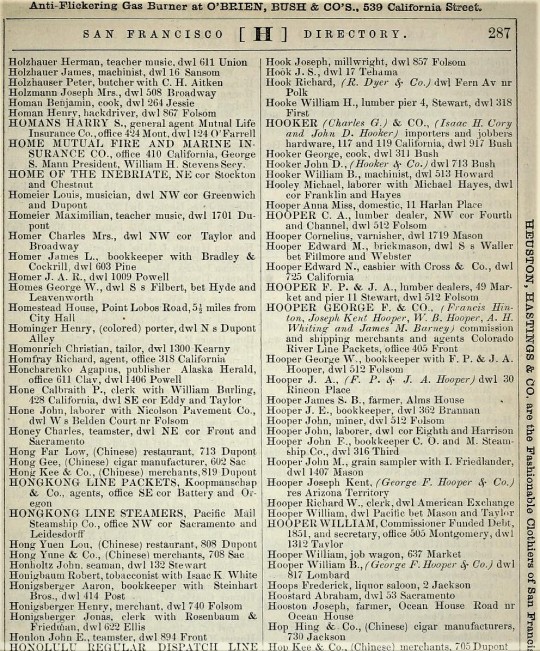
The Langley business directory of 1868 contains a listing for “Hong Far Low, (Chinese) restaurant, 713 Dupont”

“Restaurant- Cigar Factory- Dupont St. San Francisco” c. 1869 - 1892. Photograph by Isaiah West Taber (courtesy of the California History Room, California State Library, Sacramento, California). This image shows the pioneer-era restaurant Hang Far Low (杏花樓). The English letter rendering of the name, i.e., “Hang Fer Low” in the sign above the ground floor entry door at 713 Dupont Street was used (subject to publisher typos) from at least 1872 to 1906. The earliest listing of the restaurant may be found in the 1868 Langley directory.
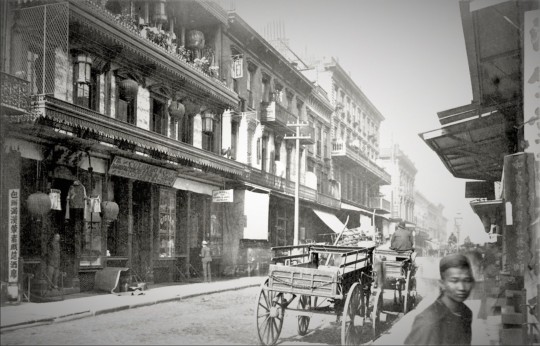
The west side of the 700-block of Dupont Street, c. 1880s. Photographer unknown. In spite of the Italian-type name, the cigar company occupying the central storefront of the building was Chinese-owned. Business directories from 1869-1892 listed in the first year a “Colombo & Co., (Chung Lung) manufacturer cigars, 715 Dupont.” Thereafter, however, the cigarmaker was usually listed as the “Colombo & Co., cigar factory, 715 Dupont.”
Moreover, the restaurant’s closure in 1960 did not represent the end of the story. Chef-restauranteur Brandon Jew resisted turning his back on a Grant Avenue building “steeped in Chinatown celebration history.” 145 years after Hang Far Low’s founding, Jew carried on the restaurant tradition in the same post-1906 building with his own popular eatery, Mr. Jiu’s. As Jew wrote in 2017 for vice.com:
“Before we renovated this space to become Mister Jiu’s, it was the Four Seas restaurant for about 50 years—hosting weddings, political fundraisers, and red egg ginger parties for the local community—and before that, it was a restaurant called Hang Far Low, which opened in the 1880s. With the shutdown of Four Seas and Empress of China—which closed around that time, too—the neighborhood lost two of the biggest and most historic places to celebrate within Chinatown. For long-established businesses, the competition to stay relevant or to become an institution is increasingly impossible.”
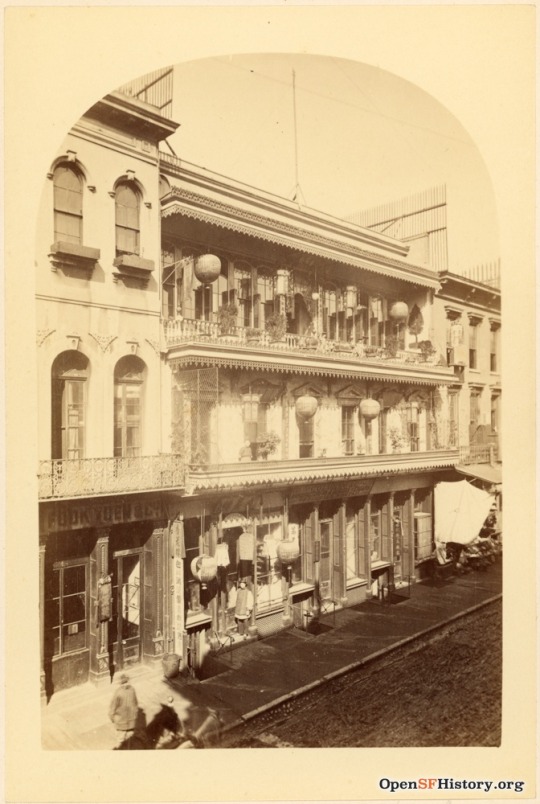
Cropped version of the photo by Carleton Watkins and published as stereo card “3759 Chinese Restaurant, Dupont near Sacramento, San Francisco” (from the Marilyn Blaisdell Collection / Courtesy of Molly Blaisdell). The above photo shows an elevated view north to the west side of Dupont Street showing Fook Yuen & Co. at 711 Dupont St., the Hang Far Low restaurant at 713 Dupont St., and Colombo and Co. Manufacturers & Dealers of Cigars, which occupied the ground floor store space at 715 Dupont St. from at least 1869 to 1892.
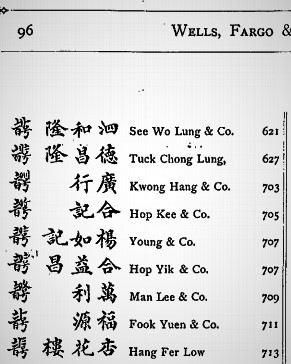

The “Hang (or Hong) Fer Low” restaurant’s listings in the 1871 and 1878 editions of the Wells Fargo directory of Chinese businesses (courtesy of the Wells Fargo Museum).
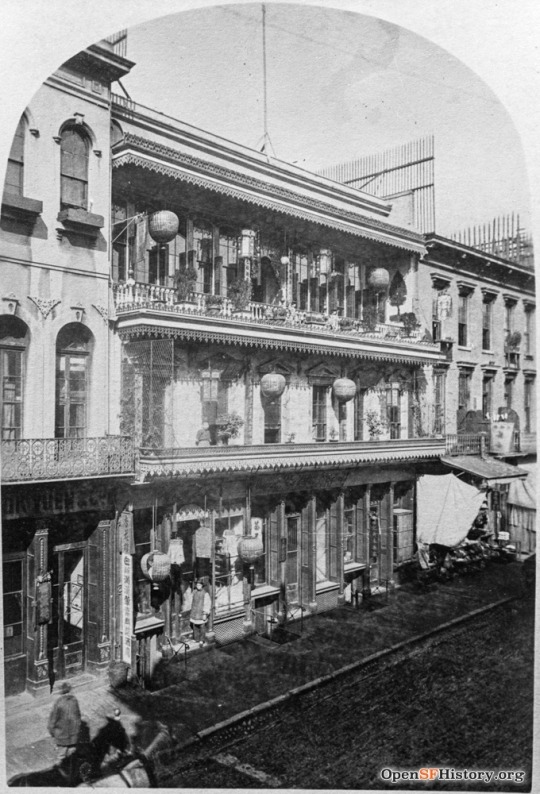
“3759 Chinese Restaurant, Dupont near Sacramento, San Francisco” c. 1882 (photograph by Carleton Watkins)
In 1888, The Bancroft Company published A Guide Book to San Francisco, by John S. Hittell, in which the restaurant’s interior space plan was described as follows:
“The Hang Fer Low Restaurant, on Dupont Street, between Clay and Sacramento, is the Delmonico’s of Chinatown. The second floor of this and other leading restaurants is set apart for regular boarders, who pay by the week or month. The upper floor, for the accommodation of the more wealthy guests, is divided into apartments by movable partitions, curiously carved and lacquered. The chairs and tables, chandeliers, stained window-panes, and even the cooking utensils used at this restaurant, were nearly all imported from China. Here dinner parties, costing from $20 to $100 for half a dozen guests, are frequently given by wealthy Chinamen. When the latter sum is paid, the entire upper floor is set apart for their accommodation, and the dinner sometimes lasts from 2 P. M. till midnight, with intervals between the courses, during which the guests step out to take an airing, or to transact business.”
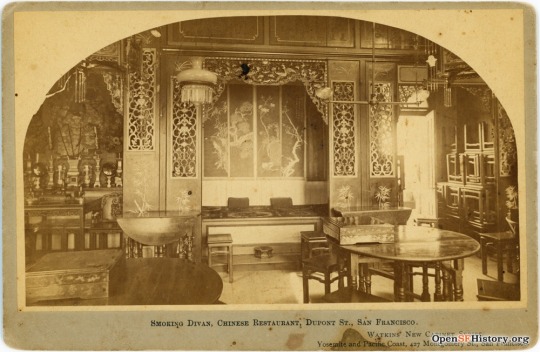
“Smoking Divan, Chinese Restaurant, Dupont St., San Francisco” circa 1880′s (Photograph by Carleton Watkins, courtesy of the Bancroft Library). An altar to the deity Guan Gung (seen at left) and seating alcove in a Hang Far Low dining room, 713 Dupont Street, ca. 1880’s.
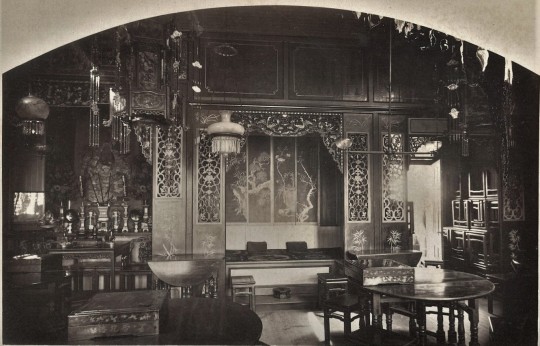
“Smoking Divan—Chinese Restaurant [Boudoir Card B3760]” c. 1880′s. Photograph by Carleton Watkins from the collection of the Bancroft Library.
The above alternative print of the “Smoking Divan” photo by Watkins is significant in at least two respects. Under magnification, the print more clearly shows the carved inscription on the wooden box in the lower left-hand corner of the image, i.e., the Chinese characters for Hang Far Low (杏花樓). Although the above image has been cropped to enhance its resolution, the image as cataloged with the Bancroft Library bears the identification as one of Watkins’ ���Boudoir Series” of photographs (B3759) as a restaurant on Dupont St. The next number in the series, B3761, was a restaurant on Jackson Street. Thus, the above two photos of the Smoking Divan provide a definitive glimpse of a portion of Hang Far Low’s remarkable interior furnishings. The image of 關公 (canto: “Guan1 Gung1″) appears in the shrine seen in the left portion of the image.
The interior dining rooms attracted other prominent photographers of the day, such as Isaiah West Taber.
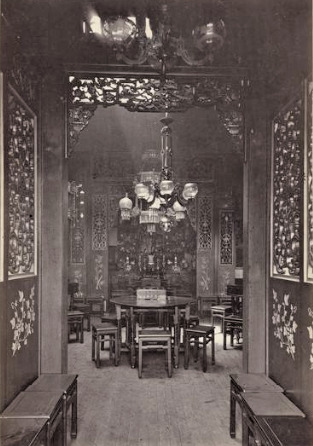
“B5 Chinese Restaurant S.F. Cal.” Photograph by I.W. Taber (from the collection of the San Francisco Public Library).
The above photograph depicts the same dining room that was the subject of Watkins’ photo of the Smoking Divan, except that Taber’s shot looks down the hallway toward the shrine to the left of the divan.
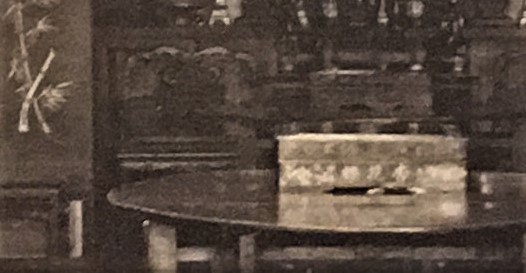
Detail from “B5 Chinese Restaurant, S.F. Cal. Photo by I. W. Taber from the collection of the California State Library. The item on the table in the center of the photo is the same Hang Far Low-branded box which is seen more clearly in the Watkins photo of the Smoking Divan.
By the end of its first decade or more, San Francisco’s Hang Far Low had gained such notoriety that city residents had dubbed it “The Delmonico’s of the West.” The restaurant’s interior captivated the photographers of that era.
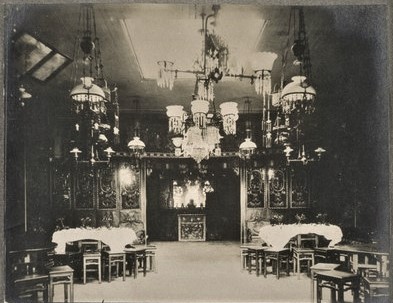
The Bancroft Library for years has only identified the above photo as an “interior of unidentified Chinese restaurant” c. 1880s. Comparison of this photograph by the Goldsmith Bros. with other copies in private collections indicates that the above photo depicts Hang Far Low’s main dining room.
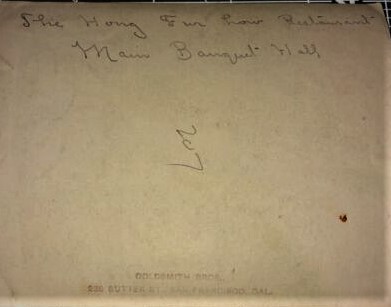
The verso of a copy of the same dining room photo (on an auction website) identifies the “Main Banquet Hall” of the Hang Far Low restaurant shown in the Goldsmith Bros. photo.
Historian Judy Yung, in her 2006 pictorial book San Francisco Chinatown described about the main dining room as follows: “The top floor of Hang Far Low Restaurant – replete with inlaid panels, carved screens, and hardwood tables and stools imported from China – was reserved for the Chinese elite and their guests.”
The exterior elevation of Hang Far Low, and its decorative balconies, continued to fascinate the photographers of that era. The restaurant appears in numerous photos throughout the latter decades of the 19th century
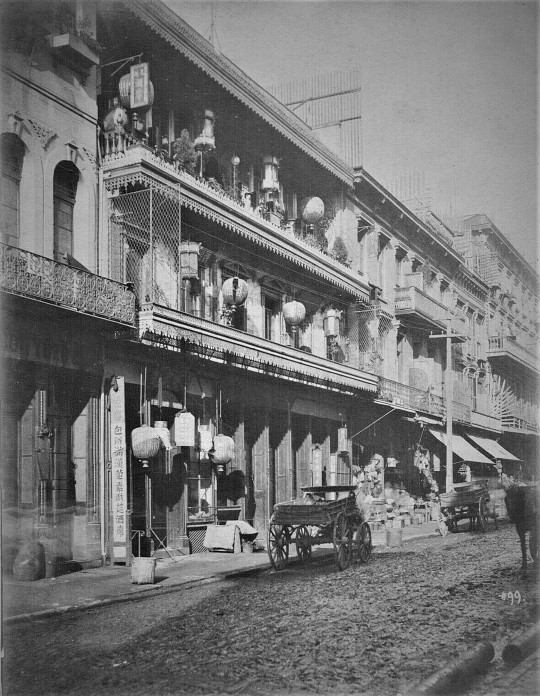
The Hang Far Low restaurant and its adjacent buildings on the 700-block of Dupont Street, c. 1880. Photographer unknown. The vertical white sign 包辦滿漢葷素戲酒席 roughly advertises “banquet arrangements for Manchu and Han meat and vegetarian feasts.”
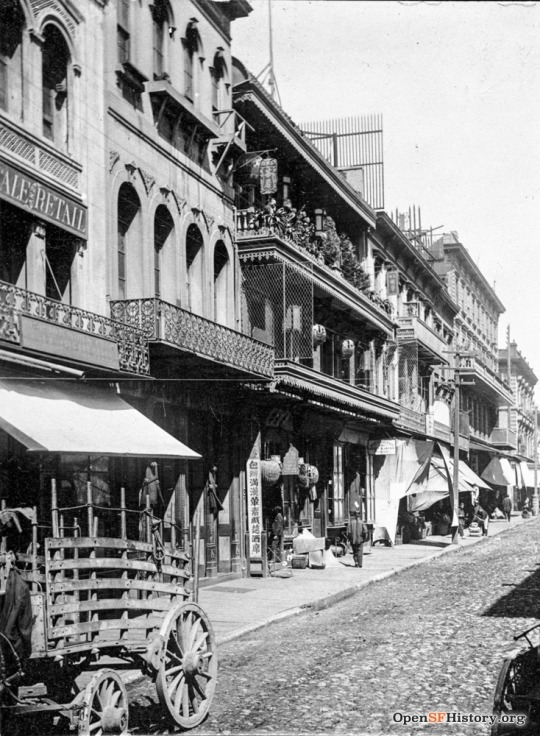
Another view of the Hang Far Low restaurant and its adjacent buildings, looking northwesterly up the 700-block of Dupont Street, c. 1880. Photographer unknown. The vertical white sign 包辦滿漢葷素戲酒席 roughly advertises “banquet arrangements for Manchu and Han meat and vegetarian feasts.”
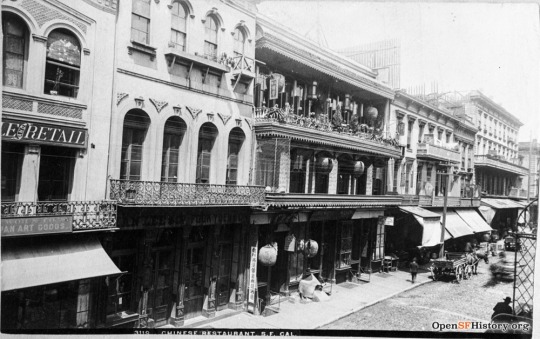
“3119 Chinese Restaurant, S.F. Cal., c. 1880s. Photographer unknown.
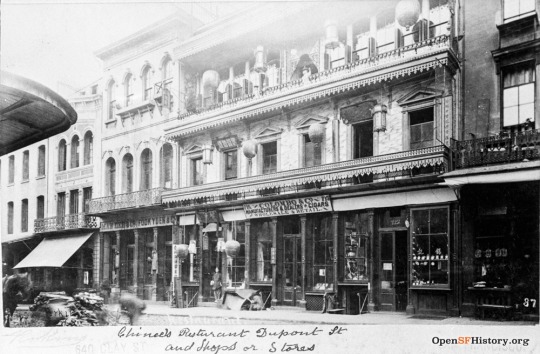
“Chinese Restaurant Dupont St. and Shops or Stores” The above photo was taken by Perkins circa 1885 (from the Marilyn Blaisdell Collection /Courtesy of a Private Collector). The southwesterly view of the west side of Dupont St. depicts from left to right Fook Woh & Co. Art Goods, Man Lee & Co. (709 Dupont), Fook Yuen & Co.(711 Dupont).
The Langley’s San Francisco directories for the years 1879 through 1883 (and probably for the balance of the decade) show both the variety store Man Lee & Co. and the drugstore Fook Yuen & Co. (the signage for which is seen clearly in the above photo), operated next door to the restaurant’s building at the addresses of 709 and 711 Dupont Street, respectively. (By 1894, other businesses had occupied the 711 Dupont address.)
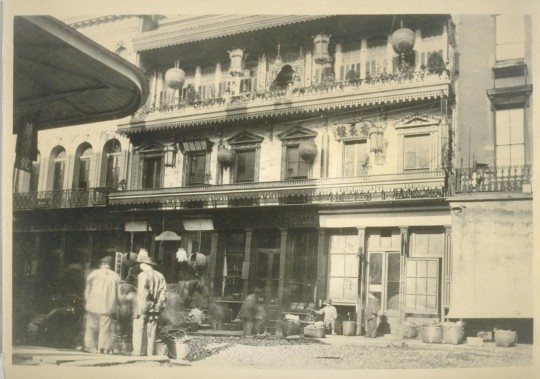
Hang Far Low Restaurant as viewed from Commercial Street looking at the west side of Dupont Street, c. 1885. Photograph probably by Goldsmith Bros. (from the collection of the Bancroft Library, University of California, Berkeley).

“Chinese Grand Restaurant, S.F., Cal.” c. 1885. Photograph by Isaiah West Taber (or O.V. Lange?).
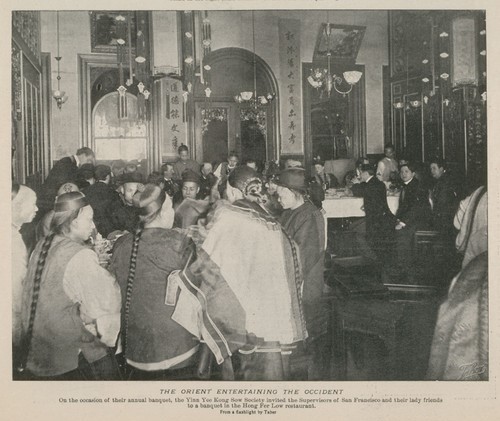
“The Orient Entertaining The Occident – On the occasion of their annual banquet, the Yinn Yee Kong Sow Society invited the Supervisors of San Francisco and their lady friends to a banquet in the Hong Fer Low restaurant. From a flashlight by Taber.” The caption indicates that Isaiah West Taber or an assistant presumably took this photograph using a “flashlight.” (Photography historians will recall that Sylvester M. Williams, a photographer, printer, and Oakland resident, worked for I.W. Taber & Co. from 1877 to 1878. Williams was known for his pioneering inventions in the field of flash photography, including the Williams Flash Light Apparatus.)
The above photograph of family association members (a branch of the Yee clan?) with members of the San Francisco Board of Supervisors provides early evidence that the Chinatown community understood the utility of feeding politicians, even if those same politicians exhibited hostility to the Chinese community. Perhaps significant, and given the relative lack of ornate decorations seen in other photographs of the Hang Far Low restaurant’s interior, the banquet appears to have been held in a lesser, more utilitarian, dining room.
In 2022, historian and author Roland Hui sent to me this comment about this banquet photo as follows:
“Taber’s flashlight photo showing a dinner gathering of Chinese and city supervisors was probably taken in 1897 since there’s a 2/21/1897 SF Chronicle article on a banquet hosted by the same Yinn Yee Kong Sow. However, I believe they made a typesetting error. It should have been Tinn (or Tin) Yee Kong Sow [ 親義公所; std. canto: “Sun Yee Goong Saw”)], the defense unit of the Four Brothers. Tin Yee was the new name of Mu Tin [(睦親; std. canto: “Mook Tun”] described in Bruce Quan’s book Bitter Roots. [The] [n]ame was changed in 1896.”
The rare shot of diners at a 19th century banquet prompts the question about the dining experience provided by Hang Far Low. The 1888 Bancroft Company publication, A Guide Book to San Francisco by John S. Hittell, described a typical banquet as follows:
“Among the delicacies served on such occasions are bird’s-nest soup, shark’s fins, Taranaki fungus (which grows on a New Zealand tree), Chinese terrapin, Chinese goose, Chinese quail, fish brains, tender shoots of bamboo, various vegetables strange to American eyes, and arrack (a distilled liquor made of rice); champagne, sherry, oysters, chicken, pigeon, sucking pig, and other solids and liquids familiar to the European palate also find their places at the feast. The tables are decorated with satin screens or hangings on one side, the balconies or smoking-rooms are illuminated by colored lanterns, and Chinese music adds to the charms of the entertainment.”
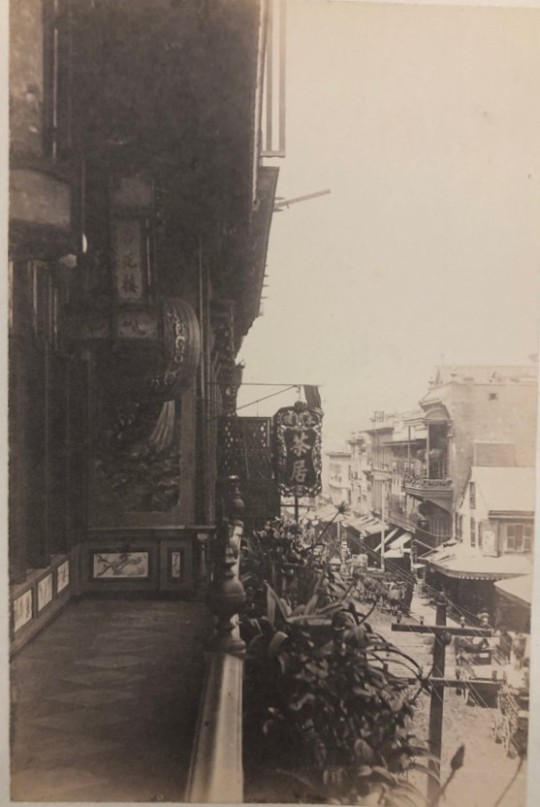
Balcony of Hang Far Low Restaurant ( c. 1885?). Photographer unknown (from the collection of the California Historical Society).
In her travelogue, Bits of Travel At Home, writer Helen Hunt Jackson (1830-1885) described the façade of the Hang Far Low restaurant as follows:
‘ Hang Fee[sic], Low & Co.’ keep it, and foreigners go there to drink tea. There is a green railed balcony across the front, swinging full of high-colored lanterns, round and square; tablets with Chinese letters on bright grounds are set in panels on the walls ; a huge rhinoceros stands in the centre of the railing : a tree grows out of the rhinoceros's back, and an India-rubber man sits at foot of the tree. China figures and green bushes in flower-pots are ranged all along the railing. Nowhere except in the Chinese Empire can there be seen such another gaudy, grotesque housefront. We make an appointment on the spot to take some of Hang Fee’s tea, on our way to the Chinese Theatre, the next evening . . .
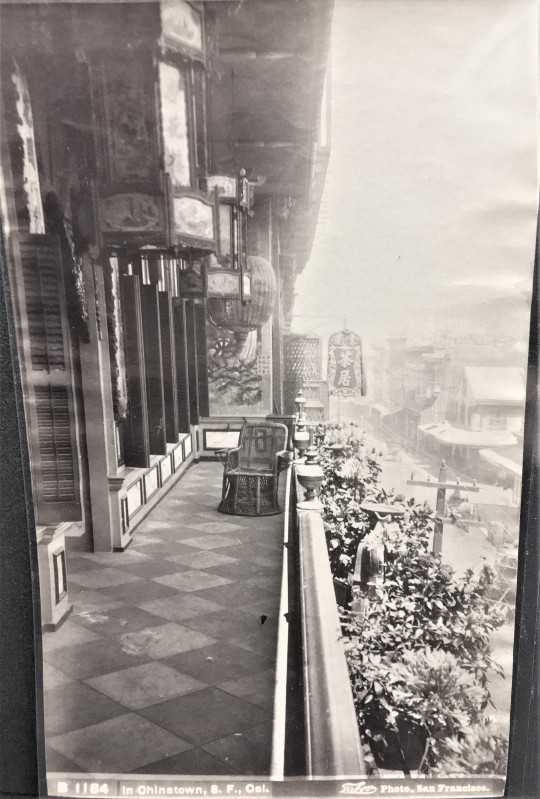
“B 1184 In Chinatown, S.F. Cal.” c. 1885. Photograph probably taken by I.W. Taber (from the collection of the California State Library). The name, Hang Far Low, in Chinese characters (i.e., 杏花樓) is clearly visible on the lantern suspended in the upper left-hand corner of the frame.
The above two photographs were taken at different times (based on the presence of the deck chair and state of the plantings) from the balcony of the Hang Far Low restaurant, looking north up Dupont Street. The first photograph evokes the style and perspective of I.W. Taber who took a similar photo from the same balcony and sold prints under the B 1184 serial number.
The upper balcony of the Woey Sin Low at 808 Dupont appears in the right-hand third of both photos, situated across Dupont and northerly and beyond the intersection of Dupont and Clay Streets (shown at the mid-right part of the photo). Only horse-drawn wagons can be seen parked at the eastern curb of Dupont which suggests the decade of the 1880’s.
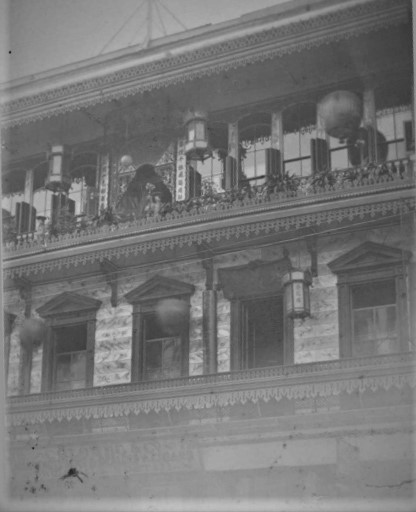
Close up of the second and third floor balconies of the Hang Far Low restaurant as viewed from the street level. Photographer unknown (courtesy of the California History Room, California State Library, Sacramento, California). The plants on the top floor and the darkened signage above the second floor window to the right of center appear consistent with the I.W. Taber photos of the balcony from the mid-1880′s, suggesting the year of the photo as circa 1885. The signage for the Colombo & Co. cigar store at 715 Dupont St. is barely visible at the bottom of the print.
Researchers of pre-1906 Chinatown owe a debt of gratitude to pioneer photographers such as Isaiah West Taber, Carleton Watkins, and others for capturing images of the interiors of the neighborhood’s grand restaurants. However, the surviving prints or plates left scant information about particular photographs, making the job of identifying restaurant interiors difficult even upon close examination.
Fortunately for Chinatown historians, Taber apparently took a series of photos of one of Hang Far Low’s mid-level dining rooms from different angles and at different times. Thus, a comparison of several photos provides important clues to identify positively a principal dining room of one of Chinatown’s legendary establishments, Hang Far Low (杏花樓), during the late 1880s.
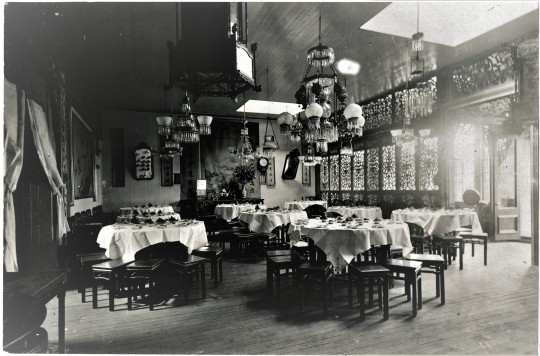
Chinese Restaurant c. mid-1880s. Photograph by I.W. Taber from the collections of the California Historical Society and the Bancroft Library.
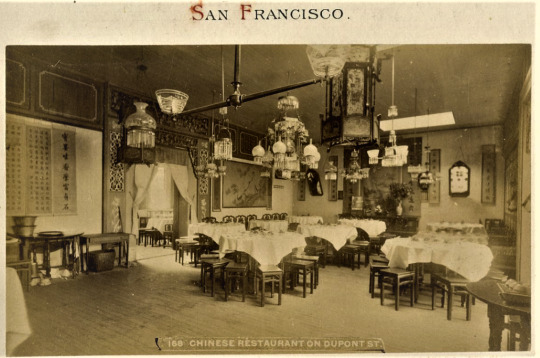
“168 Chinese Restaurant on Dupont St.” c. mid-1880s. Photograph on card attributed to I.W. Taber.
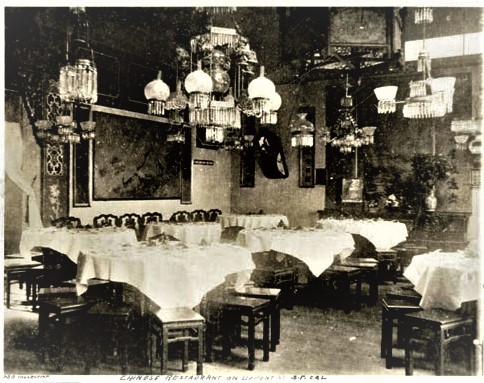
Close up of “Chinese Restaurant on Dupont St., S.F. Cal.” c. mid-1880s. Photograph attributed to I.W. Taber.
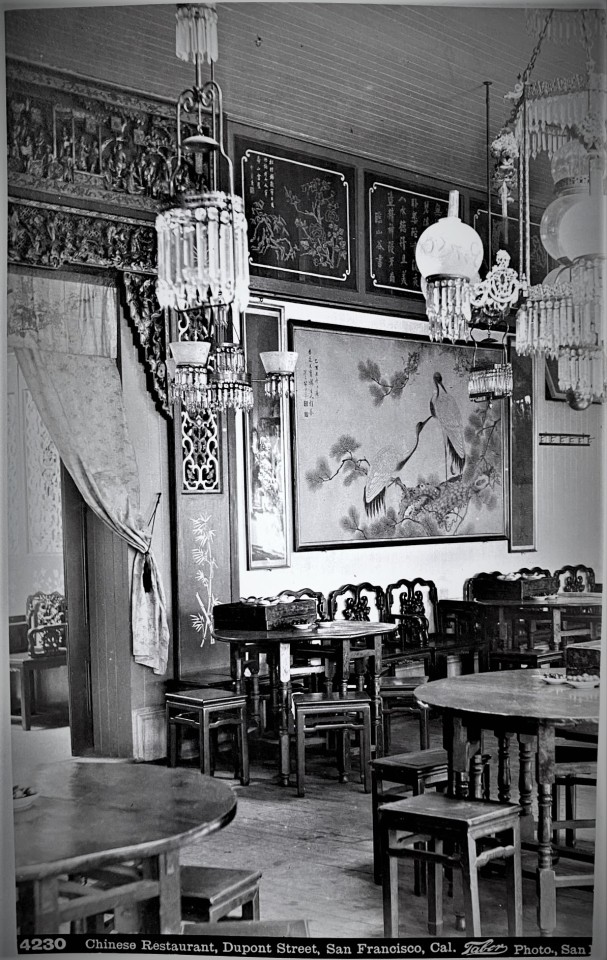
“4230 Chinese Restaurant, Dupont Street, San Francisco, Cal.” Photograph by I.W. Taber and print bearing a date of April 1, 1889 (from the private collection of Wong Yuen-ming).
Identification of the preceding two photographs of the same dining was only made possible thanks to Taber’s printing photo no. 4230, a detail of what was probably a westside interior wall of the dining room which shows clearly two important clues about its location. Taber took this photograph during the day and without the banquet tablecloths and place settings. As a result, the Hang Far Low- branded boxes (seen previously in Watkins’ “Smoking Divan” photo) were placed back on at least two tabletops.
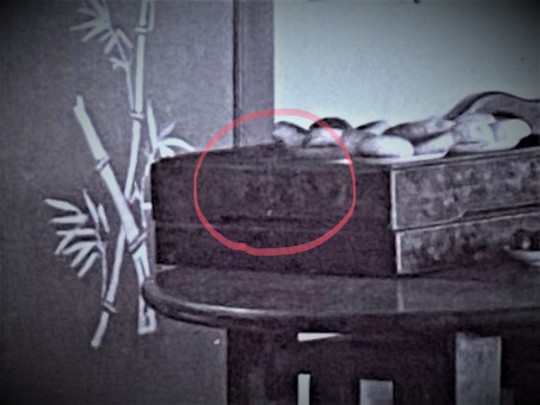
Enlargement of “4230 Chinese Restaurant, Dupont Street, San Francisco, Cal.” Photograph by I.W. Taber and print bearing a date of April 1, 1889 (from the private collection of Wong Yuen-ming).
A close inspection of the box in the center of photo no. 4230 reveals the Chinese characters for the Hang Far Low restaurant (from right to left: 杏花 ), as well as the same detail on the panel of the wooden screen seen in the background.
The case for locating the dining room shots at Hang Far Low is further bolstered by the inscription seen in the upper left corner of the wall painting.
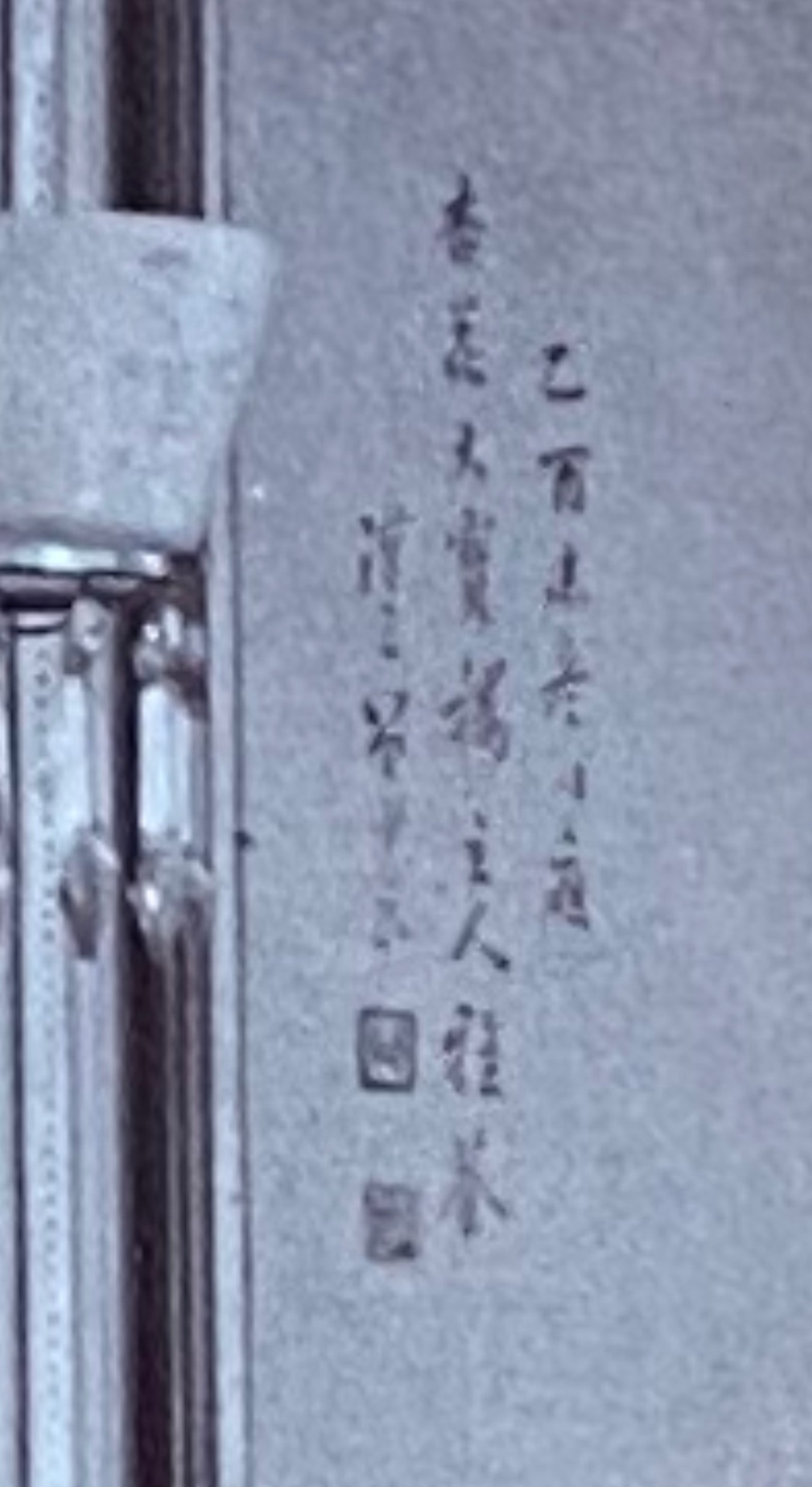
Enlarged detail from “4230 Chinese Restaurant, Dupont Street, San Francisco, Cal.” Photograph by I.W. Taber and print bearing a date of April 1, 1889 (from the private collection of Wong Yuen-ming).
On the left side of the wall painting the first two characters (read vertically from right to left) are 乙酉 pinyin: “Yiyou”; canto: “Yuht Yau”) indicates, according to the collector Wong Yuen-ming, the date around which the painting was given to the restaurant, which “might be 1885 or any 60 years before.” The center or second line of characters appears to read: 杏花大賣場 (lit.: “ “; pinyin: “Xìng huā dà màichǎng”; canto: “Hahng Fah dai mai cheung”). Assuming that the characters 杏花 refer to the restaurant, Wong surmises that the 大賣場 represents a form of exhortation or wish for Hang Far Low to make money.
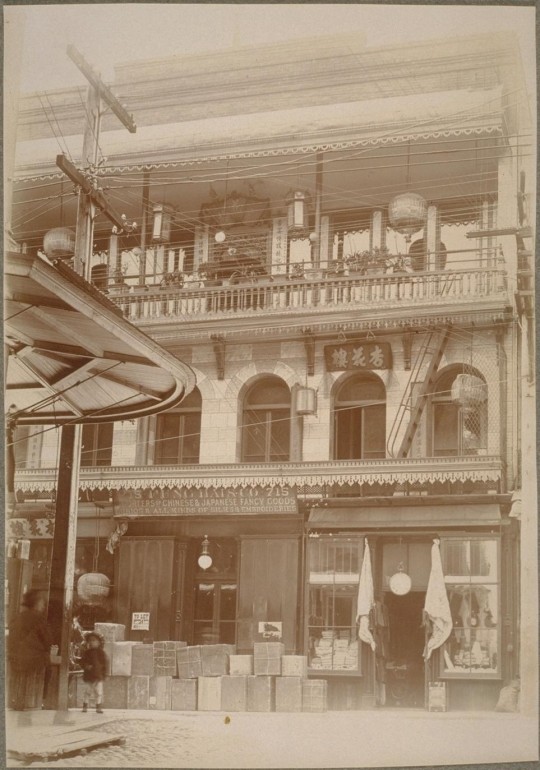
Exterior of Hang Far Low (photographer unknown, c. 1894)
By the 1890s, when the above photo was taken (from the west end of Commercial St. looking at the restaurant situated on the west side of Dupont Street), the Colombo & Co. cigar store had departed, and the 715 Dupont Street address in the building had become a gift bazaar. The view of the second floor shows alterations to the façade and arched window frames with more prominent Chinese character signage. A dozen years later, the building would be destroyed completely in the Great Earthquake and Fire of 1906.

Post-earthquake exterior of Hang Far Low restaurant (photographer unknown, c. 1907).
Chinatown was rebuilt in place after the earthquake and fire, and a new home for the old Hang Far Low restaurant was built in 1907 into which the new restaurant would move at 735 Grant Avenue. This photo showing the new restaurant was taken from approximately the same location on Commercial Street as shown in pre-1906 photos. The striking addition of an oriental-style cupola on the roof, and visible from the street, exemplified the architectural flourishes of the new “Oriental City” into which the neighborhood had been transformed. The availability of “Chop Suey” is prominently advertised by signage on the second floor balcony. The Hang Far Low sign above the door is seen at left, and it reposes today in the collection of the Chinese Historical Society of America. The awning of the Hee Jan furnishings store can be seen in the center space of the store frontage at 737 Grant.
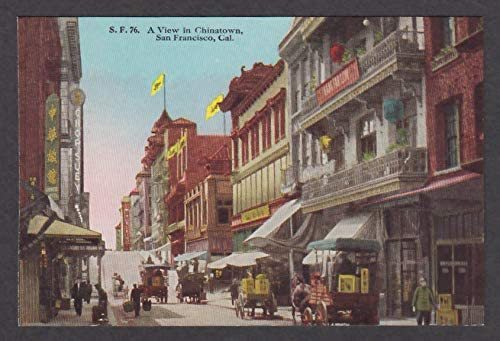
“S.F. 76. A view in Chinatown, San Francisco, Cal.” Given the vintage of the signage depicted in the postcard, the painting appears to depict the new post-1906 Chinatown and is itself exemplary of the success of the community’s survival strategy to cater to the tourist trade.
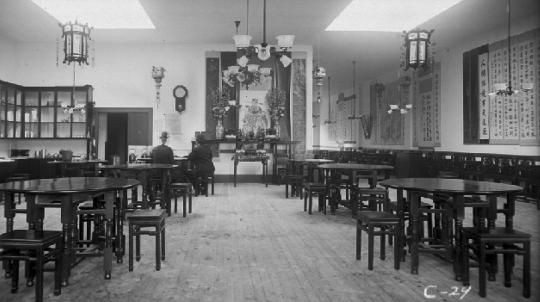
The new banquet dining room of Hang Far Low (c. 1908 by Martin Behrman). The third floor banquet hall of the new Hang Far Low restaurant one year after the construction of the new building admitted plenty of sunlight, but never equaled the opulence of the pre-1906 grand dining room.

“Banquet in San Francisco Chinatown” c.1910. Photographer unknown (from the Jesse B. Cook Collection at The Bancroft Library).
As is evident from the above photo, purportedly taken in 1910 to honor members of the San Francisco Board of Supervisors, the merchant and other leaders of the Chinese community resumed using Hang Far Low for cultivating influence with public officialdom.
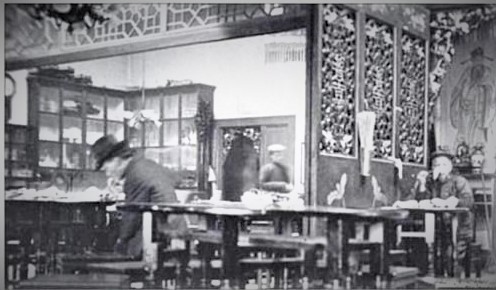
“Common Dining Room” c. 1911. Photograph by Louis J. Stellman (courtesy of the Society of California Pioneers).
Historian July Yung wrote in her pictorial book San Francisco’s Chinatown (published by the Chinese Historical Society of America) about the post-1906 incarnation of Hang Far Low’s serving Chinatown’s workers as follows:
“The middle floor of Hang Far Low housed the kitchen and served more common fare to Chinese shopkeepers and workers during the day. Some restaurants offered monthly coupons for meals at different prices. Cheaper restaurants that served simple rice and noodle dishes were usually located in the basements of buildings.”
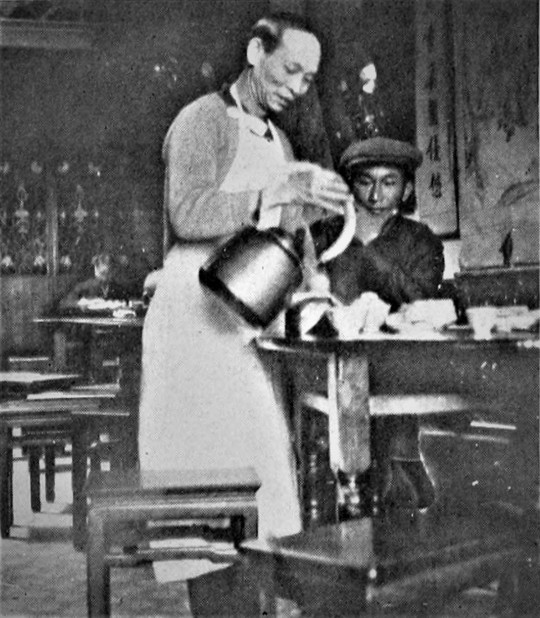
A waiter pours tea for a customer in Hang Far Low’s middle floor dining room, c. 1911. Photograph by Louis J. Stellman (from “Camera Craft – A Photographic Monthly” ed. Sigismund Blumann, vol. XL, no. 1 (January 1933). Stellman took this photograph using a small box camera. “Another luck shot was in the Hang Far Low restaurant,” Stellman wrote 22 years later. “Setting my camera on a table I chanced a fifth of a second exposure of a Chinese waiter pouring hot water into a tea bowl. He was talking at the time but the print shows little movement. “

Photograph of a banquet held in the main dining room of Hang Far Low, circa 1912. (Photographer unknown from the collection of Bruce Quan). The event was possibly hosted by prominent businessman Lew Hing.

Hang Far Low restaurant looking northwest across Grant Avenue, c. 1917. Photographer unknown from a private collection.
The 1907 building (designed by architect Albert Pissis) appears a decade later with additional signage advertising a Restaurant and Tea Garden from the third floor balcony. A man carrying basket approaches the photographer’s position on the east side of Grant Avenue. Above the next door entryway at 717 Grant, the American flag shares space with the white sun on sky blue background flag of the six year-old Republic of China, as does the entrance to the Jee Jan store at 737 Grant.
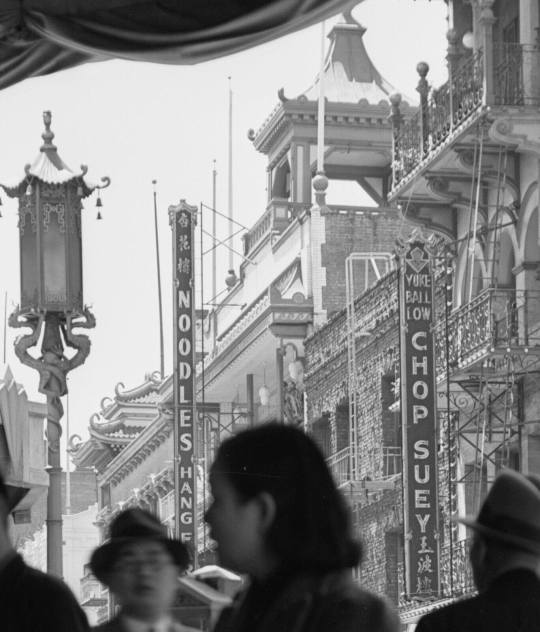
Vertical, neon signage in the daytime for Hang Far Low and Yoke Ball Low restaurants appear prominently in this photograph from 1939 of Grant Avenue’s west side. The “Yuck Ball Low” restaurant (as listed in the Polks Crocker-Langley directors of 1939 was located at 747 Grant Avenue.
Architectural historian Hongyan Yang writes about Hang Far Low’s building in her upcoming book as follows:
“… The property was owned by Paul Fleury and Leonide Arizerais. This three-story three-bay building was designed by Albert Pissis and completed in 1907. Among one of the first generation American architects trained in Paris, Pissis was highly influenced by the Baroque and Renaissance traditions, and was actively involved in rebuilding downtown San Francisco after the 1906 earthquake. His design of the Hang Far Low building also consisted of collections of Oriental details and decorations that were commonly employed in the buildings of Chinatown. In addition to the vibrant colors of green and red, the most evident feature was the cupola tower that perched on top of the building. Compared to typical cupola towers found in Renaissance-influenced architecture, Pissis dressed this square copula in an Oriental fashion, accentuated by the red and green color schemes and upturned eave ends to evoke a sense of exoticism associated with a Chinese pagoda tower. Different from the religious pagoda towers in China, the cupola tower kept its western ornamental connotation and was used vertically and scenically in the composition of Oriental architecture, without any adjacency to a monastery and religious significance. Different from the intricate structural system of a Chinese pagoda tower, it featured a much simpler structural system with straight crossed beams and columns. In fact, American architects were keenly aware that these newly constructed buildings with Oriental features like a pagoda tower did not represent traditional Chinese architecture… . “
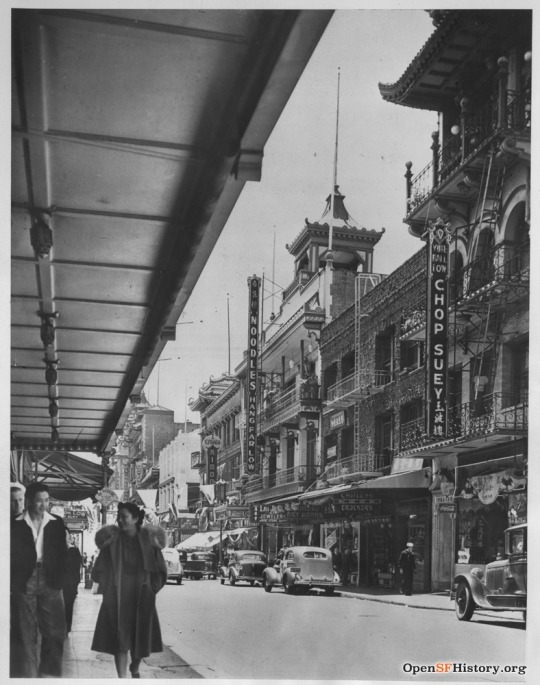
The west side of the 700 block of Grant Avenue in 1945.
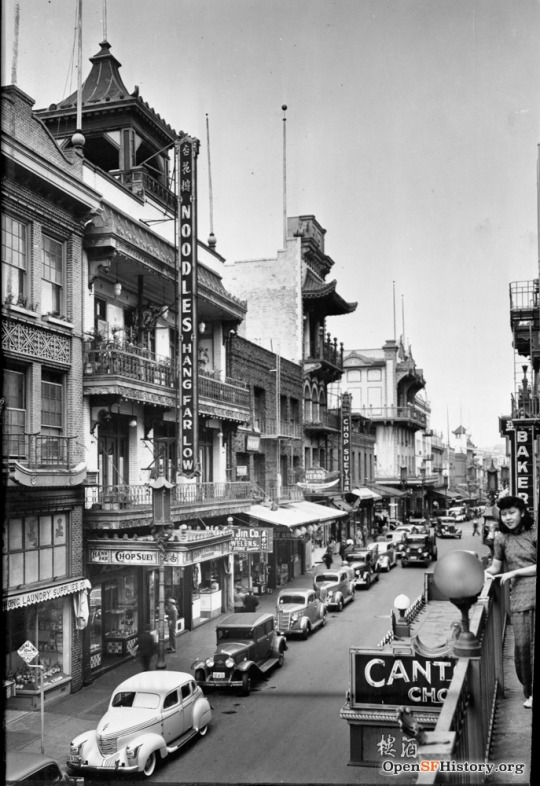
By Mar 10, 1945, when the above photograph was taken of the view north along the west side of Grant Avenue, a hard awning had been built over the sidewalk fronting the entrance to Hang Far Low restaurant. The bakery sign in the right of the photo over the woman’s left shoulder was for the old Eastern Bakery which operates today at 720 Grant Avenue.
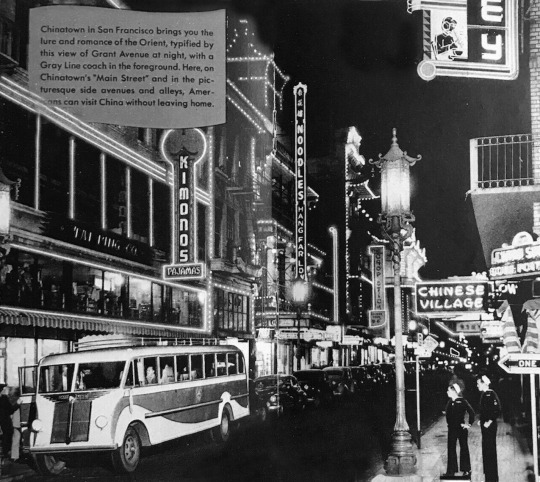
Nighttime on Grant Avenue during the 1940s, and the heyday of San Francisco as a Navy town.
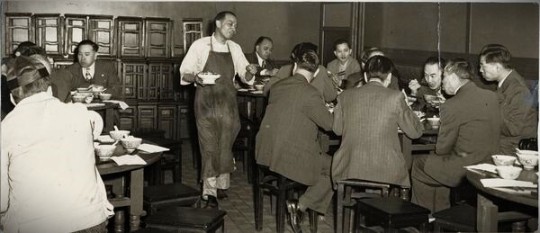
A waiter (伙記; canto: “fo2 gei3) serves a table of postwar Chinatown businessmen probably in the middle dining room of the Hang Far Low restaurant on February 9, 1946. Photographer unknown (from the collection of the San Francisco Public Library).

A postcard of mid-century Grant Avenue.
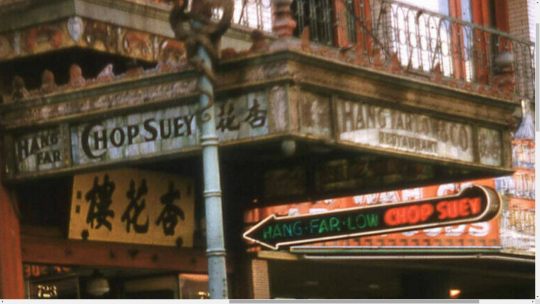
A 1954 close up of the Hang Far Low awning signage over-hanging Grant Avenue. The sign over the doorway was salvaged and accessioned to the collection of the Chinese Historical Society of America.

The remodeled banquet room for the new Four Seas restaurant.
By 1960, the family of the controlling partner of the Hang Far Low restaurant no longer wished to operate it, and the establishment was sold in 1960 to operate under the new name of Four Seas.
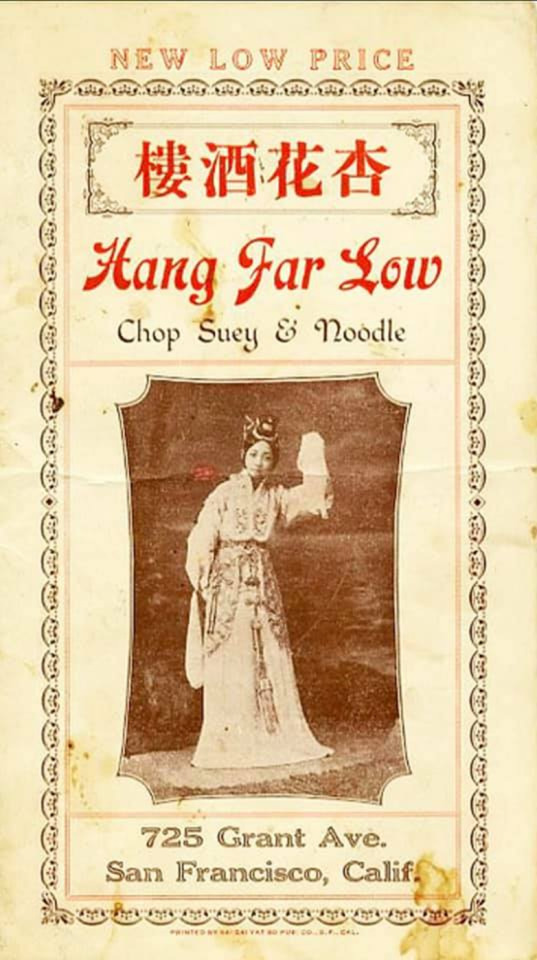
The legendary eating establishment that had served San Francisco’s Chinatown for a century had come to an end.
The history of Hang Far Low implicates a less examined, but deeper, narrative, wherein the Chinese learned that the banquet halls could serve as tools for civic engagement with the greater San Francisco community and its political institutions.
In the first quarter of the 21st century, however, banquet culture in SF Chinatown has waned substantially due to a confluence of factors. Demographic changes, pandemic lockdown and stigmatization, the dispersion of Chinese communities throughout the Bay Area, and the corresponding decline in Chinatown’s role during the era of exclusion and segregation as the principal market and financial hub had all converged to end the 170 year-old institution of the banquet hall in Chinatown.
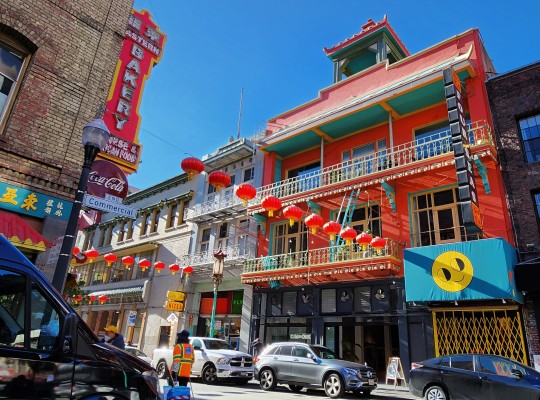
The building which housed the Hang Far Low and Four Seas restaurants at 731 Grant Avenue, January 5, 2024. (Photograph by Doug Chan). Since the rebuilding of San Francisco’s Chinatown after the disaster of 1906, the building continues to house the restaurant operations of the highly-rated Mister Jiu’s, a contemporary Chinese American and bar. The entrance to the modern-day restaurant is located on the west side of the building at 28 Waverly Place. As almost a metaphor for the reinvention of Chinatown and the restoration of its banquet rooms, the Executive Chef, Brandon Jew, and his team have gradually expanded operations within the building to its remodeled top floor’s “Moongate Lounge.”
[updated: 2024-1-19]
#Hang Far Low#Chinatown banquet culture#I.W. Taber#Carleton Watkins#Louis Stellman#Thomas W. Chinn#Long Kong Tin Yee Association#Tin Yee Association#Mu Tin Association#Brandon Jew#Judy Yung#Four Seas restaurant#Colombo & Co. cigarmaker
0 notes
Note
cym as books
This is horrible.
@confused-as-all-hell is Circe. This one is right though.
@thehalfbloodfreak Little Women.
@iambecomeyourvillain Daisy Jones and the Six.
@twelve-kinds-of-trouble Dorian Gray.
@the-sky-is-full-of-stars Illuminae.
@saltyfortunes Hamnet.
@ds-umbrella-manufacturing-co Night Circus.
@drunk-on-inejs-laughter Song of Achilles. Maybe.
@revvs-trash If We Were Villains.
17 notes
·
View notes
Text
More Last Holiday Musings...
I want to poke at that interdimensional geoscope a little more, because upon reading it over again, I think I splashed it up a little fast and there are a couple of points I’d like to be clearer about. I meant to queue this up to post last night but also want it to be up before Gimme Shelter so ¯\_(ツ)_/¯
This is more blue curtains lit crit with a dash of folklore and an honorable mention for post-structuralism. And we’re talking about Supernatural after all, so this is sort of... well, it’s about endings.
Last Holiday was not a typical “filler” or even a typical MOTW episode. It felt extremely insular, possibly more so than any other episode I can think at any other point in the series. As opposed to the usual crowd of “locals,” a spate of victims, and a couple of red herring suspects, the only other people in this ep besides the Winchesters (including Jack) and Mrs. Butters were the two vampires and Cuthbert Sinclair. There was no “case” as in a usual MOTW-- there was no Chuck Struggle, either, and the lack of mytharc was strange against the lack of “filler” schema. That lack of “MOTW investigation” marked this episode also as being about “curiosity”-- the Winchesters all-too-quickly took Mrs. Butters for granted-- Dean even dismissed her as a “Magic Roomba” and that seemed to settle the matter. Furthermore, the moment that Dean spotted Mrs. B in his room, the stage was set for Antics ™ when she held up his goofy Scooby boxers, and indeed a zaniness, an almost manic energy drove the action forward at a breakneck pace. [Spoiler alert, we do get “investigation” in the next episode, 15x15 Gimme Shelter, as stills and the preview show that Castiel and Jack will be teaming up together, in yet another shake-up of the usual “MOTW” template, almost like we can expect the other side of a coin when Sam and Dean switch places with Cas...] These features set Last Holiday apart as not so much “filler” as “between,” as in there was struggle before, and there will be struggle after, but for a while there was cake. (Contrast this to the usual “peril of the threshold” that usually shrouds liminality if you’d like.)
At the end of Last Holiday, however, we finally get to find out what that old blue telescope really is, and with that name we get confirmation that there are no more alternate universes-- Chuck has burned them all. Viewers are left to come to the conclusion that in retrospect the telescope-thing could have changed the course of season 13 completely. The reveal is played off as darkly funny, but it’s also kind of a gut-wrenching moment, too. All the heartbreak of the last two and a half years, reviewed now through the lens of “if only.” If only they’d known about Mrs. Butters from the time they found the bunker, “none of this would have happened”… they’d have had monster radar, they’d have had the geoscope, they would have had supernatural help of a completely different level.
The temptation to read Last Holiday as a Chuck-free episode is strong, but fraught-- the threat of Chuck’s involvement has been established by a pattern this season (well the pattern is woven throughout the whole series really but Dabb has deliberately structured these last three seasons with an exponentially increasing frequency.) I feel like we’ve been conditioned this season in particular to hold ourselves in a perpetual flinch, to be afraid of what we’ll learn “in retrospect.” That geoscope was really_good_subtext, and it is entirely possible, even encouraged, at this point in the plot to take information we’ve learned from the naming of the object, examine our own conditioned response to this episode, and apply both things to the structure of the season so far and make a prediction as to what might happen in the main plot. That’s what I mean about subtext getting loud. We’ve been given the green-light to make a prediction about The Struggle and march forward with it, and see if we will be correct by extrapolating the pattern, or if that expectation will be subverted (the twist is set up to run either way, so either outcome is satisfying.) It is Melville-esque architecture of the highest degree;I could write another thousand words just about that. So I have a prediction that I’m hanging on to, because of what we’ve learned from the geoscope, and what kinds of clues were hung up in Last Holiday, and I’m super excited to either have my hunch confirmed or be frightfully and delightedly surprised. I mean, where the fuck did Jeremy Adams even come from? He’s like our own Mrs. Butters, showing up in the last quarter to run a couple game-changing balls into the end zone, it’s bonkers. I mean, I know writing mysteries is hard and requires still AND cunning, but damn, son.
But anyway, back to the geoscope…
I’m perplexed, from a very “lit crit” perspective, but this is where I’m at and why I referenced blue curtains-- if you shine too bright a light on subtext, does it evaporate-- like looking through an interdimensional geoscope and not seeing anything-- or is “subtext” sometimes not some ephemeral fever-dream that we as viewers conjure up through our experiential interlocution with the text but something a writer has steeped into the narrative as part of their craft? Or when you’re talking about an evolving iteration of writers, is it possible that one picks up a thread that another wove in for something else, repurposing or amplifying it? And, when perhaps is something deliberately instilled in the text in order to become “text” at just the right time? In Moby Dick, [spoiler alert lol] Quequeg’s coffin-- formerly one of many symbolic vehicles used to foreshadow the doom of the Pequod-- is repurposed as a life buoy and becomes the actual object that saves Ishmael’s life, transforming it from a portent of disaster to a symbol of salvation and then to one of Ishmael’s guilt for surviving Ahab’s madness-- the guilt that had been made text by the very opening line of the book, “Call me Ishmael.” In retrospect, the connotations of wandering, exile and salvation behind the name that the narrator gives himself become crystal clear. The problem that the post-structuralist model of “reading” as simultaneously “creating the text” has manufactured is that the idea that “subtext” can often be discounted as something dreamed up wholecloth by the reader, and thus inferior, imaginary, even delusional (and I use that last word knowing what a loaded term that is in the spn fandom, but this is not about a ship, even) where once it was considered to be a valid and measurable part of the text itself, like that dang coffin. It was the basement, the underpinnings, the catacombs below the opera house sure, but it helped to hold up the structure. And for some reason, putting subtext into a piece of media has become passe, or cringe? Anyway, not to be bitter on main but it didn’t used to be this way, at least not in the heady early days of postmodernism. So that green light? Critical hit against blue curtains. And while yes, some readings are going to be better supported than others, and the wild variety of checklists in this fandom mean that some conclusions have been drawn which can’t pan out, if you’re paying attention to the structure, the subtexts, the alchemical/psychoanalytical/postmodern themata, the ending will be very satisfying.
So. What was once speculated to be a symbol for emotional lows or turning points (among other things) in the bunker was textually hit with a bright green light, then Dean got curious about it in text, and we were told-- in text-- that oh it’s just a fancy spyglass, and now that the other worlds are gone, it has no purpose…. that’s what I mean about the geoscope now being “pure”-- it wasn’t clear whether the telescope ever had any function, subtetxtual or not, and now that it’s certain what it’s “function” was, it’s now freed up as a “symbol”-- unless like in Moby Dick it’s new “purpose” is revealed later, but right now it’s caught in this liminal place of not-quite-clue and not-quite-metaphor...
However, and I didn’t put this in my first post because I was trying to be fast and not a wet blanket, but I felt like finally naming the geoscope was an ending.
This is literally Singer, Dabb, and Co tidying up the house before locking it behind them.
I think when Dean said he didn’t see anything through the “telescope thing,” that we’re to understand that maybe this was the last hurrah of the cute, zany, campy “subtext” or even “metatext” if you’d rather that so many of us have been parsing and which has gotten so weird and bright since season 12/13. I think I said in one of the folklore posts that writing about some of the things I write about feels like making daisy chains in the endzone during the big game. Which is fun, that’s how I personally got through having to be in AYSO soccer for four years, by looking for four leafed clovers and eating orange quarters. And we got a wood nymph in this episode, textually even, so I could easily check the “folklore” box on this one. But the sheer euphoria of Last Holiday and all the sparkles it brought into the story aren’t meant to last. When you look back on fifteen years of text, a lot of it is bleak, miserable stuff. That’s not to say that episodes like Yellow Fever and Hunteri Heroici and Fan Fiction et al shouldn’t be celebrated. But I think from here on out, things are going to be less “golly gee, three birthdays!” and more “There she blows! --there she blows! A hump like a snowhill!”
This episode was a gift in many ways, not just for the sense of glee it transmitted-- it also did so much work and there are things I want to yell about in the way language was hit, the red versus green lighting, the way the backwards holidays worked, the projector as a metaphor for Mrs. B projecting her regrets and fears onto Jack, the amount of food that was created and consumed, how that smoothie was also an echo of “fairy food” or an underworld pact if you squint-- but the stakes are so high now. We haven’t been shown the next valley-- there was no final scene of Chuck rubbing his hands together like the villain from a melodrama, for example-- but the last image we got was Jack blowing out a candle. After the candle is blown out, the cake is dismantled and consumed. Once the story is over, all the themes that are so hard to grapple in a text like a television show can be gathered up and analyzed. (IS that all, though? After all, Dean made his own cake later, which, like, echoes of the “oh two cakes” comic lol...)
Since I really never want to leave anything I toss out on this blog on a last note of doom and gloom, however, I do want to say that I too understand what that last image meant. It meant, as Sam said, make a wish. Think of the future, think of free will, and hope for something wonderful to happen. (or do like me and wonder what the hell Jack wished for with dread and anticipation ha ha ha.)
#the poststructuralism of supernatural#the folklore of supernatural#no more tags right now#tag later
49 notes
·
View notes
Photo

Daisy Manufacturing Co, 1967
215 notes
·
View notes
Photo

Carabina de vaquero Red Ryder de 1000 disparos, Daisy Manufacturing Co, 1943
1 note
·
View note
Text
These Australian Designers Are Changing The Textile Industry
These Australian Designers Are Changing The Textile Industry
TDF Design Awards
by Amelia Barnes

Kip&Co with Bábbarra Women’s Centre, Kip & Co x Bábbarra. Photo – Caitlin Mills.
Kip&Co with Bábbarra Women’s Centre, Kip&Co x Bábbarra
Kip&Co and the Bábbarra Women’s Centre joined forces to create this spectacular range of textiles and homewares, developed over two years. The collection features eight unique artworks from seven Bábbarra Women’s Centre artists – Deborah Wurrkidj, Elizabeth Wullunmingu, Helen Lanyinwanga (deceased), Janet Marawarr, Jennifer Wurrkidj, Margot Gurawiliwili, and Raylene Bonson. Every element, from the artwork selection, to product range, colours and labels, has been led by the women at Bábbarra.
Profits from sales of the collection will be divided equally between Bábbarra and Kip&Co, and copyright specialists the Copyright Agency were engaged from the very beginning of the project to ensure best practice for licensing and ethical processes were upheld throughout its execution.
The Bábbarra Women’s Centre is one of the most important community spaces in Maningrida, a remote Aboriginal community in Arnhem Land at the tip of the Northern Territory.
Revisit our feature on this collection and collaboration here.

Gorman and Mangkaja Arts Resource Agency, Mangkaja x Gorman. Photo – Charles Fréger. Annie Cooper, Annie Coop Textiles. Photo – Lillie Thompson.
Gorman and Mangkaja Arts Resource Agency, Mangkaja x Gorman
Iconic fashion label Gorman worked with Mangkaja Arts Resource Agency in Fitzroy Crossing to produce a collaboration with five senior Aboriginal artists: Ngarralja Tommy May, Sonya Kurarra, Daisy Japulija, Nada Rawlins and Lisa Uhl. The collection was photographed in Fitzroy Crossing, and the collection was modelled by local women.
The two-year development process around this 25-piece collection was supported by the Copyright Agency as a national benchmark in fashion licensing rights, making the adaptation of the Mangkaja artists’ works on Gorman silhouettes a landmark achievement. Funds from the sale of the collection were donated to Mangkaja Arts Resource Agency to support youth programs within the art centre.
Revisit our story on this collaboration here.
Annie Cooper, Annie Coop Textiles
Australian textile studio Annie Coop is owned and operated by designer Annie Cooper. The label’s fabric design, production, and manufacturing are entirely conducted in Melbourne, and sold in interior showrooms throughout Australia, New Zealand, Canada, the USA and UK.
Taking cues from her travels throughout Mexico and Spain, Annie has created an original aesthetic with an uncompromising approach to quality, craftsmanship and sustainability. Her made-to-order fabrics are printed on ethically sourced linen, recycled polyesters, and cotton wallpaper using large format digital textile printers.
Revisit our feature on Annie Coop here.

Ellen McKenna, From Art to Fashion. Photo – Kirsten Bresciani
Ellen McKenna, From Art to Fashion
The debut large-scale, solo exhibition of artist Ellen McKenna showcases the complex process of developing a garment of clothing through art. Titled ‘From Art to Fashion’, the exhibition takes the form of a step-by-step visual journey, beginning with painted canvas artworks, then patterned fabric displays, and sewn garments. The show’s objective is to highlight clothing garments as items of worth – an alternative to the seasonal turn-arounds of the disposable fashion model.

Magpie Goose, Magpie Goose x Ikuntji Artists. Photo – Sarah Mackie. Castle, Little Garden Bedlinen. Photo – Caitlin Mills.
Magpie Goose, Magpie Goose x Ikuntji Artists
Magpie Goose is a platform for Aboriginal artists to share stories and generate income through the creation of wearable art. The objective of the Ikuntji Artists collaboration (a member-based, not for profit, Aboriginal art centre led by a board of seven local Indigenous directors) in particular was to showcase the stories of female artists from the Western Desert.
This capsule clothing collection features eight unique designs originally created by five senior female artists from the Ikuntji (Haasts Bluff) community, located 230 kilometres west of Alice Springs. These artworks designs were then set up for screen printing by Magpie Goose, and eventually crafted into clothing.
As a non-Aboriginal owned business, Magpie Goose fosters the celebration of Aboriginal culture, people and stories through the medium of fashion, and helps to create meaningful opportunities for financial gain for their First Nations collaborators.
Castle, Little Garden Bedlinen
The Little Garden range combines hand painted aspects of Castle’s art practice with the commercial production of bedlinen. The collection began as a small painted artwork of a garden, created on paper using pencil, crayon, oils, gouache, acrylic, texta and pastel. Ordinarily this artwork would be reduced down to seven or eight colours before being printed onto products, but for the first time in Castle’s history, this design was digitally printed to capture every single colour and brushstroke of the original artwork. The Little Garden range includes quilt covers, sheets, pillowcases, and a bedspread.
Revisit our feature on this collection here

Baina, Collection .01. Photo – Greta van der Star. Pampa, To-yik-ca. Photo – Victoria Aguirre.
Baina, Collection .01
Melbourne-based label Baina was founded by Anna Fahey and Bailey Meredith. Drawing on their experience in the fashion industry, the pair set out to create considered, organic cotton bath towels that would complement and elevate the commonly neutral bathroom.
Baina’s inaugural range is a seven-piece collection designed to work in any combination, allowing customers to mix and match colours and prints. Products are made from 100 per cent organic cotton and produced in Portugal by a Global Organic Textile Standard certified mill.
Revisit our feature on Baina’s debut collection here.
Pampa, To-yik-ca
The To-yik-ca rug collection is a collaboration between Byron Based homewares label Pampa and the Wichí (Indigenous) peoples of Argentina. This collaboration saw Wichí and Andes weavers engaged to create textiles, which were adapted by Pampa to a large format for the weaving of the rugs.
Designs in the To-yik-ca (meaning ‘loom’ in the local dialect of the Wichí people) collection are representative of the traditional lands of the Wichí people. The end result is a beautiful collection of rugs that balance the contemporary with the traditional. Rugs in this collection feature bold geometric shapes inspired by nature, woven in sheep’s wool, and dyed in Pampa’s signature earthy and pastel tones.
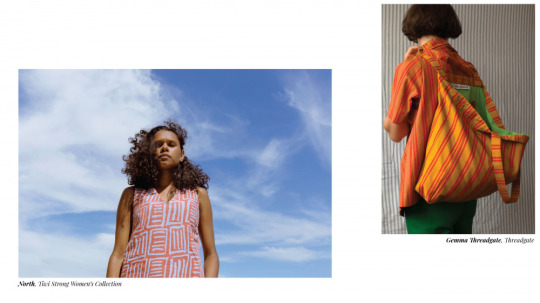
North, Tiwi Strong Women’s Collection. Photo – Matt Sav. Gemma Threadgate, Threadgate. Photo – Natalia Parsonson.
North, Tiwi Strong Women’s Collection
The Tiwi Strong Women’s Collection is the latest fashion collection from not-for-profit organisation North, in collaboration with the Jilamara Arts and Crafts Association.
In this collection, artists of Pirlangimpi and Milikapiti and Waurrumiyanga were invited to share their culture through hand screen printed fashion. Each of the designs was handmade in the community, printed in a workshop with artist Timothy Growcott, then hand-sewn in Melbourne.
North exists as a vessel to celebrate, support and broaden the exposure of textile design by Indigenous artists from remote community art centres. They are a non-Aboriginal owned business, governed by Indigenous and non-Indigenous board members.
Revisit our feature on this collection here.
Gemma Threadgate, Threadgate
If names are anything to go by, Gemma Threadgate chose the right creative pursuit! The Sydney-based textile designer produces small-scale collections for her eponymous label from start to finish, which means designing, hand-printing, cutting and sewing the clothing and homewares with the help of one other maker.
Inspired by Ted Spagna’s 1975 book, Sleep, which explores the intimate narratives of human sleep behaviour through time-lapse photography, Gemma linked the universal act of sleep with the repetitive motions of screen printing.
Threadgate’s subsequent six-piece Sleep collection comprises a newly designed trouser, shirt, dress hat, tote bag and cushion cover. The capsule is guided by slow fashion principles.
We’re proud to partner with heritage Australian brand Laminex to realise The Design Files + Laminex Awards program 2020. Laminex is Australia’s leading supplier of modern laminates, quality engineered stone, timber panelling and more. Find out more here.
Winners of the The Design Files + Laminex Design Awards 2020 + Laminex will be announced November 5!
2 notes
·
View notes
Text
Plot Contrivance, thy name is Season 6...
S.H.I.E.L.D. learns in 6x05 through Benson's research that the crystalline spikes that erupted from shriked!Keller (R.I.P. Boyfriend Plot Device) are similar to the monoliths’ molecular structure.
The reason why Benson compares them to the monoliths is because Elena, who is not a scientist nor has any kind of scientific training that we know of, nonetheless immediately picks up the similiarities between the scan of a dead shrike and what at some point she must have seen of a monolith (when? I don't know/recall. She was stuck in bed during the Fear Dimension crisis but she’s smart and inquisitive, she probably asked for details of what was going on. It’s not important. What matters to my following points is that the Plot requires the character to remember and the character does, even if it happened off screen and it’s easier to come up with reasons for why she wouldn’t).
In 6x07 Fitz and Simmons learn that Izel is after the monoliths. This Fitz doesn’t know about the Monolith Triptych in the Lighthouse (he learns of their existence by 6x10) but knows - or should know - a hell of a lot about the Space Monolith that transported Jemma to Maveth (2x22). He studied it obsessively for six bloody months. And he eventually figured out how it worked (3x02):
Quantum harmonic oscillation theory, like the professor said. [...] It's a strange shape for this time period because it's made to resonate, uh, to create a-a quantized field within the stone.[...]The room is a speaker. The machine is an amplifier. Uh, a sub subsonic frequency to resonate with the Monolith.
And, interesting point, while Coulson & co. during this explanation were exchanging dumbfounded looks, Daisy was actually following along and came to the conclusion on her own:
I can do it. I can open the portal myself. If the point of the machine was to resonate the room at a certain frequency, I can do that.
So. Fitz knows that at least one of the monoliths can be activated by a subsonic frequency that Daisy can produce and saw it happened. Daisy also knows this because she made it happen and knows that she accidentally reduced that monolith to pebbles (Fitz of course knows this too as he ended up covered in them). If Izel wants the monoliths, being able to destroy them could be useful, yes? And Jemma also knows all of this because it’s how she was saved and because she then studied how she was saved to find a way to rescue Will.
So, why does none of this ever come up? Elena immediately spotted the similarities between those two scans, one of which she must have seen more than a year earlier yet FitzSimmons - trained genius scientists - and Daisy - who’s quite smart if lacking academically - can’t see any possible connection nor, apparently, have any recollection whatsoever of such a pivotal event in their lives? Daisy almost died. Fitz and Simmons were almost lost forever. Are we supposed to take in that none of it could be relevant to the current crisis?
Then in 6x11 we have this gem:
Fitz: This sword is a more complex version of these other blades. Simmons: Which were able to kill her shrike. Fitz: So, Sarge's hypothesis that the sword could be used to kill Izel does have merit. Simmons: The metal has a familiar crystalline structure. Fitz: Like the monoliths. So it could be reversed-engineered to manufacture more weapons. Daisy: None of this matters unless we can get within stabbing distance.
So. A familiar crystalline structure that is like the monoliths still doesn’t trigger any recollection in our resident geniuses to arrive at the conclusion that resonant frequencies might be relevant to Izel’s powers and vulnerabilities until Deke gets there on his own, catching on something Sarge said (to Daisy). While Daisy, who was able to destroy a monolith with her powers - yes, by accident. Accidents can be replicated, real life scientific discoveries have been made this way - is worrying about stabbing distance. Well. Okay then.
And since I don’t want to leave anyone out of this embarrassing dumbfest, during the exchange I quoted, Deke comments that he saw firsthand how effective the blades are against the shrikes, a reference to May stabbing one right before it shut him up entered his mouth.
However, FitzSimmons the Younger has apparently forgot all about how Daisy turned a bunch of those same shrikes into dust. What, that did not make an impression? That isn’t relevant either? Not even a little bit? Not even to at least have Team FitzSimmons say “too bad we can’t have Daisy doing that because *insert sciencebabble BS reason of choice*”, so during the finale we aren’t left wondering why Quake is suddenly useless?
#what was even the point#just make up something different#that doesn't make your characters come across as amnesiac#or plain dumb#or have daisy being injured so she can't quake#so you can give her a gun#after 3 seasons in which she never carried one#because she has SUPERPOWERS#and can manipulate VIBRATIONS#sound is a vibration#agents of s.h.i.e.l.d.#aos#aos season 6#daisy johnson#jemma simmons#leopold fitz#yo yo rodriguez#deke shaw#dr. benson#text post#aos meta#my meta
52 notes
·
View notes
Photo
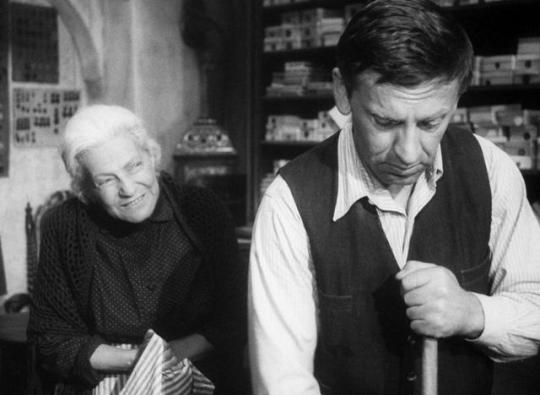
The Shop on Main Street (1965, Czechoslovakia)
Putting “New Wave” in a sentence referring to a film movement is asking for trouble. Whether the New Wave is French, Iranian, or Japanese in origin, the term implies a series of films and filmmakers breaking narrative and aesthetic norms in conventional moviemaking, exalting innovation. New Wave directors from those respective countries include Jean-Luc Godard and Agnès Varda; Forough Farrkohzad and Mohsen Makhmalbaf; Nagisa Oshima and Seijun Suzuki. For those I have just listed, I am not denying their talents, their importance to film history. But show any of their films to someone who is less familiar with these New Waves, without the contextual understanding of the environment their works were released, and befuddlement and distaste will likely abound. Rare is the New Wave film that can be shown to unfamiliar eyes and minds without appropriate context.
Ján Kadár and Elmar Klos’ The Shop on Main Street (adapted from Ladislav Grosman’s novel of the same name) is sometimes considered a part of the then-concurrent Czechoslovak New Wave. And if one considers it part of that New Wave, then it is one of the more comprehendible, technically grounded films of that movement. It certainly qualifies as one of those New Wave exceptions – a film that can be digested by a viewer not accustomed to older movies or has any experience with Czech- or Slovak-language cinema. I consider The Shop on Main Street a Czechoslovak New Wave film. When one looks beneath its World War II-era surface, its politics extend beyond its condemnation of Nazi Germany’s treatment of Jews and the local Slovak population. Though rooted in the nation’s past, it was as timely as Věra Chytilová’s Daisies (1966) upon release. The film outdoes many New Wave films by playing fast and loose with genre expectations: a black comedy in the first half, a tragedy in the second. Nazi Germany’s state-executed hatred, if not including the fringe groups inspired by their example, is no longer; Czechoslovakia has long been split in two. The Shop on Main Street and its censure of those who manipulate the oppressed, while pointing their fingers elsewhere.
In March 1939, the Slovak Republic was carved out of Czechoslovakia as a client state of Nazi Germany. The Slovak Republic never received recognition from the Allies (with the brief exception of the USSR until they were invaded by Germany), and they soon set about the process of Aryanization. Aryanization was a process in which Jewish property and businesses were to be put into “Aryan” ownership so as to “de-Jew” the economy. In The Shop on Main Street, Slovak carpenter Anton "Tóno" Brtko (Jozef Kroner) is offered by an official the ownership of a button store owned by the elderly, near-deaf Rozália Lautmannová (Ida Kamińska). Mrs. Lautmannová, a widow, is unaware that there is a war, that Czechoslovakia is being occupied by invaders intent on seizing her business and exterminating her fellow Jews. She welcomes Tóno as a helper and believes – mishears, really – that he is her nephew. Tóno, thrown into this awkward situation, soon learns that Mrs. Lautmannová’s store is not profitable and depends on community donations. The Jewish community implore Tóno to stay as de jure owner of the store, for fears that a more exploitative owner might be selected were he to give it up. Tóno agrees, accepting a small payment, and dedicating himself to the store’s and Mrs. Lautmannová’s welfare. They find time to see the humor in her mishearing and his stubbornness. In the final scenes, Tóno and Mrs. Lautmannová must make a horrific decision.
Czechoslovakia’s communist government, during the Czechoslovak New Wave, frowned upon films that could be construed as anarchic, insurrectionist, troublemaking. The Shop on Main Street – unlike many of its contemporaries – avoided government meddling. The villains here are the Nazis, whom communist forces across the Eastern bloc fought against. On its surface, The Shop on Main Street assigned no criticism towards Czechoslovakia’s communist regime or to communism. Yet the braggadocious Nazis are a minority in this film. A detestable sociopolitical minority becomes empowered when others sympathize with them, rationalize their prejudices and atrocities, and fail to defend the targets of that minority. We see non-Jewish Slovaks shrugging their shoulders about Aryanization. Why not pocket some extra money with this new policy, they reason, in a sluggish economy and a better-armed invading force now patrolling their streets? These are economically desperate times for non-Jewish Slovaks (and, if my hunches are correct, probably even more so for Jewish Slovaks), so they will use whatever programs necessary to survive, rooted entirely in self-interest.
The communist censors probably thought something, while viewing The Shop on Main Street, that is resurgent in modern-day Europe: that Nazi Germany’s anti-Semitic policies (from Aryanization to concentration camps and much more) were Germany’s responsibility and no one else’s. Complicity with the Nazi agenda is being debated among historians, politicians, and within the 125-minute runtime of The Shop on Main Street. For Tóno, the invaders inspire mutterings out of earshot and disdainful moues. His wife, Evelína (Hana Slivková), is concerned only about money – she is thrilled when she learns that the Aryanization program will give them a financial cushion (so she thinks), never contemplating the possibility this it is the beginning of the Jewish community’s ruin. Has she ever known someone from the community? It is not clear. Tóno’s non-Jewish acquaintances, too, are unfazed by these proclamations. Life is already difficult in the Slovak Republic (Czechoslovakia itself was not formed because its patchwork of ethnicities had common political pursuits and aspirations, but due to expedience and tensions with other ethnic groups), and any economic lifeline that will be offered to the non-Jews will be taken. Are those who support and/or participate in Aryanization irredeemable, given their desperation and the Nazi aim to manufacture conflict between Jews and non-Jews? Is Tóno an accessory of the Nazis?
These are questions that may seem small when grasper the enormity of the Holocaust. But that is the intention of directors Kadár and Klos, who often worked together co-directing films. In his directorial statement for the film in the New York Herald Tribune’s January 23, 1966 issue, Kadár (whose parents and sister were murdered at Auschwitz) writes that he was the principal director for this film – Klos agreed to be a sort of secondary director for The Shop on Main Street, deferring to Kadár because of his personal connection to the material. Klos also notes:
[Klos] knows that I am not thinking of the fate of all the six million tortured Jews, but that my work is shaped by the fate of my father, my friends’ fathers, mothers of those near to me and by people whom I have known. I am not interested in the outer trappings—figures, statements, generalizations. I want to make emotive films.
This is not an epic film intended to sweep viewers into the broadest discussions of the Holocaust. The Shop on Main Street is foremost a film about an unlikely connection – one separated by age, language, and faith – that is formed when exploitation would be so much easier. This is where The Shop on Main Street derives its pathos, in places where despair ought to triumph.
When Tóno meets Mrs. Lautmannová for the first time, he is surprised to see how disconnected she is from the world. She knows little of what is happening outside of the storefront door, and she delights in the company of her few – but dedicated – customers and the letters she receives from a relative in America (she hasn’t received their letter in some months). She closes the store on the Sabbath (sundown on Friday to sundown on Saturday), retreating to her bedroom to pray and to read. Her friends in the Jewish community realize her frailty and lack of understanding, deciding to protect her from the news of pogroms and war. When lacking any authority to make laws or force political change, all they possess are their words and neighborliness – which they share with Tóno freely. Tóno is struck by their generosity, and his friendship with Mrs. Lautmannová grows. Ida Kamińska (the Polish actress was sixty-six years old when The Shop on Main Street was released, and nicknamed the Mother of the Jewish Stage) and Jozef Kroner (a star of numerous Slovak films, but this is his most recognized work) play off each other. In a series of successive (gentle and dark) misunderstandings, these two commoners are each other’s foils. He is a drinker, impatient, and needs to learn diplomacy. She is kind, religious, and concerningly naïve.Their performances are incredible, helping The Shop on Main Street pull off its tonal transitions that should have seen this film crumble into treacle.
youtube
Zdeněk Liška’s score to The Shop on Main Street alternates between foreboding string lines wracked with minor key, string-crossing double stops signaling the precariousness of the story’s developments, the unusual situation the characters find themselves in, and emotional torment. A memorable, carnival-like march that opens the film is used to stunning effect when employed ironically. Liška’s cue placement helps Kadar and Klos achieve the respective comedic and dramatic moods that the screenplay and actors so nimbly establish.
Lengthy is the canon of films depicting and commenting on the Holocaust. The Shop on Main Street, avoiding extensive declarations, is one of the earliest films on that list. Its examinations on complicity and the extent of human callousness reverberate to a present where Holocaust denial and blame-shifting continues to rail against the truth of untold millions and their descendants. It is a tremendous film, one containing unexpected power through its performances and the impossible situations the main characters find themselves in. Bathed in white, the final seconds of The Shop on Main Street show a wonderful dream, one that could only be crafted by a director pouring his decades-long grief for his parents and sister into his work. As the camera dances to the right, away from the shop on main street, we see in the background the shops and homes of the Jewish community now silent.
My rating: 10/10
^ Based on my personal imdb rating. The Shop on Main Street is the one hundred and fifty-eighth feature-length or short film I have rated a ten on imdb.
#The Shop on Main Street#Jan Kadar#Elmar Klos#Ida Kaminska#Jozef Kroner#Hana Slivkova#Martin Holly Sr.#Frantisek Zvarik#Ladislav Grosman#Zdenek Liska#Vladimir Novotny#Czechoslovak New Wave#TCM#My Movie Odyssey
2 notes
·
View notes
Text
Purina vs IAMS
https://www.centralparkpaws.net/wp-content/uploads/2019/08/51oF4IDUbAL.jpg When I was younger, pretty much everyone fed their dog Purina or IAMS.
They were household brands and, at the time, two of just a few brands commonly seen in the grocery stores.
Not to sound like an old lady here, but back in my day, there weren’t big chain pet stores, and there weren’t any pet boutiques.
So, what happened to dog food companies like Purina and IAMS when the dog food market exploded?
I still see them on the shelves, but I tend to walk by them without thought.
However, I recently found out that my mom buys Purina for her dog. I was more than surprised to hear this and found out that it was our vet that recommended it.
I trust our vet and always go with their recommendations, but I couldn’t help but wonder why of all brands she would recommend Purina.
Are Mainstream Food Brands Any Good?
Vets are recommending this dog food now?
The last time I was in with one of my dogs for a check-up, I had to ask about her food recommendation.
My vet said she understood my surprise, but that brands like Purina and IAMS have really improved the quality and varieties of foods they offer.
Over the last several years, they have been forced to change to keep up with the growing market.
She also pointed out that the boutique foods are under scrutiny by the FDA as to the long-term effects concerning dilated cardiomyopathy (DCM).
The concern with the “boutique” foods is that they believe the grain-free foods are the cause of the increase in cases of dogs suffering from DCM.
So, many veterinarians are falling back on more tried and true brands such as Purina and IAMS.
Then at the end of my visit, the vet suggested I try ALPO kibble for Daisy.
She laughed at the look on my face when she suggested it. But she stated that it is a balanced diet and a lot of seniors that are picky eaters, like Daisy, tend to like it.
Purina’s Company History
Purina has a very long history, stretching as far back as 1894[1].
Back then it went by the name of Robinson-Danforth Commission Company for two of the three founders.
In 1902, they changed the name to Ralston Purina.
They originally started as a farm animal food company but over the years evolved into one of the biggest dog food companies in the industry.
In 1987, Purina shared their findings after a fourteen-year research project. The research proved feeding your dog appropriate foods throughout the different life stages can significantly impact the health and longevity of your dog.
In 1988, Purina launched the first hypoallergenic food that isolated the allergens and removed them from the food, creating a diet that was nutritious as well as safe for dogs with food allergies to eat.
Over the next years, Purina continued to grow, both in the pet food industry but also in different markets such as treats, dental chews, probiotics, and more.
In 2001, Nestle purchased Purina, making Purina a globally recognized name.
As of 2018 Purina is the second-largest dog food company in the world[2].
Purina’s 3 Best Sellers
Purina One Smart Blend – Chicken and rice
Purina One Smart Blend is a balanced food for adult dogs that don’t have special dietary requirements.
The food is enhanced with antioxidants to promote a robust immune system.
Purina Pro Plan Focus – Sensitive skin and stomach
Purina Pro Plan Focus is formulated to be rich in fatty acids to help improve good skin health.
Also, it has been enhanced with prebiotics for a healthy digestive system. Purina Pro Plan is not a hypoallergenic food, and it does contain grains.
Purina Pro Plan SAVOR– Shredded blend with chicken and rice
Purina Pro Plan Savor is a highly digestible food containing prebiotics and probiotics to promote good digestive health.
This food has both dry kibble and shredded soft dog food to provide a more appealing texture for your dog.
IAMS’ Company History
IAMS started in 1946 by Paul IAMS.
Paul IAMS would later launch the first animal-protein rich dog food, which was named IAMS 999.
In the 1980’s, IAMS introduced their life stage dog formulas.
Then, in the 1990s, IAMS launched their natural dog food line and publicized their findings regarding the positive effects of fatty acids on a dog’s skin and coat.
IAMS was privately owned until 1999, when Procter and Gamble purchased it[3]. When P&G purchased IAMS Co, they announced their intentions of expanding IAMS globally.
Later in the 2000s, IAMS brought their most advanced dog food formula line, Premium Protection, to market. Premium protection is a specially formulated food for puppies.
Finally, in 2014, MARS company announced the purchase of IAMS from P&G[4]. MARS is the largest dog food company in the world.
IAMS’ 3 Best Sellers
IAMS Proactive Health Adult – Chicken MiniChunks
IAMS Proactive Health is an excellent all-around food for adult dogs.
Chicken is the first ingredient in this formula, followed by corn and whole grain sorghum. It also contains beet pulp and prebiotics for healthy digestive systems.
IAMS Proactive Health – Large breed with chicken
Farm-raised chicken is the main ingredient in this food.
The chicken and chicken fat are a good source of glucosamine and chondroitin, which promotes healthy joints[5].
Like the other Proactive Health recipes, it contains an abundance of nutrients and vitamins to ensure a balanced diet.
IAMS Proactive Health Smart Puppy – Large breed
This food is designed to help large breed puppies grow and develop at the proper pace. It also contains Omega-3 DHA to aid in brain development.
Finally, it has been enriched with 22 nutrients that are found in the puppy’s mother’s milk.
Purina Recalls
Purina has only had one dog food recall in the last ten years.
In August 2013 there was a recall (that included only one food, Purina ONE Beyond) due to possible Salmonella poisoning[6].
IAMS Recalls
No aflatoxin any more!
IAMS has had two dog food recalls in the last ten years.
In December 2011 there was recall (for only one food, Iams ProActive Health Smart Puppy) due to possible aflatoxin contamination[7].
Then, in August 2013, there were six dry dog foods involved in a recall[8]. The recall was due to suspected salmonella contamination.
Healthy Naturals Weight Control Adult
Healthy Naturals Chicken Adult
Premium Protection Chicken
ProActive Health Small Breed
ProActive Health Large Breed
ProActive Health Large Chunks
Since the 2013 recall, IAMS has not had any additional recalls.
What’s Important When Choosing a Dog Food?
There is a multitude of components that go into deciding on the ideal dog food.
Often, we only think of ingredients, and though that is a significant part of the decision process, it isn’t the only factor to take into consideration.
Other things specific to your dog’s dietary health requirements are essential when picking the right dog food.
Also, there are aspects of the decision-making process that do not have anything to do with your dog. But these elements are still essential when deciding on the best food for your dog.
There are two tiers to consider when deciding on the right dog food for your pooch.
The first tier is made up of factors that directly relate to your dog’s specific needs, like:
Weight
Breed (German Shepherds and Goldendoodles do better on different foods)
Activity Level
Size
Age (the best dog food will change as your dog grows from puppy to adult)
Health – Various diseases like Cushing’s, heart disease, diabetes, and kidney disease, and GI issues
The second tier is made up of less critical, but still significant elements like:
Availability
Taste (what your dog thinks)
Price
Where the food is manufactured
Where the ingredients are sourced
Comparison of Purina vs. IAMS
Ingredients
Winner: IAMS
This was close, as the majority of the ingredients are similar.
However, I chose IAMS because of the additional superfoods found in their Proactive Health blend.
I compared each of the best sellers: Purina One Smart Blend Chicken and Rice and IAMS Proactive Health Adult Minichunks.
IAMS Proactive Health Adult Minichunks’ ingredients list
Purina’s first ingredient is chicken, which is one of the natural sources for glucosamine.
Also, this food contains a variety of grains rice, wheat, and corn. There are a lot of added vitamins and nutrients listed, but not a lot of superfoods like spinach or blueberries.
However, they do use a variety of kibble to enhance the texture of the food.
IAMS first ingredient is also chicken, followed by two different grains.
IAMS also includes dried beet pulp to enhance the digestibility and promote good GI health. Also, this blend includes superfoods like blueberries, spinach, and apples.
Price/Value
Winner: IAMS
The average price per pound for IAMS is a hair over one dollar per pound. For Purina, it’s three cents more expensive per pound.
The ingredients are pretty similar, but IAMs won because of the additional superfoods.
Combined with the ingredients and lower price, IAMS won for price and value as well.
Availability
Winner: Purina
Both brands can be found at the larger pet stores and online.
However, Purina is also available at more grocery stores and some boutique pet stores.
Varieties
Winner: Purina
Purina is the winner with 96 unique recipes.
Purina Varieties
Purina has 96 different dry dog foods listed on their website. There are 7 different lines within these 96 foods.
Purina One – 18 Varieties
Purina Pro Plan – 41 Varieties
Purina Dog Chow – 10 Varieties
Beneful – 11 Varieties
Beyond – 9 Varieties
Bella – 2 Varieties
ALPO – 2 Varieties
Amongst these lines, they have specific recipes for seniors, puppies, large breeds, giant breeds, toy breeds, small breeds, weight management, hypoallergenic, skin and stomach sensitivities, grain-free, and sport.
IAMS Varieties
IAMS has 21 different dry dog foods listed on their website. These 21 foods are broken down into three categories:
Nutrition Tailored to a Dog’s Age and Size – 8 Varieties
Nutrition Tailored to a Dog’s Unique Dietary Needs – 4 Varieties
Nutrition Tailored to a Dog’s Breed – 6 Varieties
Within these three lines, there are specific recipes for weight management, grain-free, and high protein.
Taste
Winner: IAMS
Even though the ingredients look similar to me, IAMS was the winner by a landslide.
I can’t even begin to imagine what IAMS has that Purina does not.
Never mind, yes, I can imagine.
Purina has the “tender meaty morsels,” which I thought dogs would prefer over standard dry kibble, but I guess I was proved wrong.
X-Factor
Winner: Purina
Both companies support their communities, but Purina’s work stood out more to me.
Purina:
Donates $10,000,000 annually to Rescue Bank[9]. Rescue Bank aids animal rescues through donating foods from various animal food vendors.
Supports Leader Dogs for the Blind.
Partners with local animal shelters all over the US.
Supports Adopt a Pet.
Supports Duo Dogs, a program that connects dogs and people to help enhance their lives.
Supports Dogs on Deployment assisting troops in finding a safe place to board their pets while on deployment.
Partnered with St. Louis Children’s Hospital and funded a room for children to be able to visit with their pets while staying in the hospital.
Red Rover and Purina started the Purple Leash Project to aid in keeping victims of domestic violence together with their pets in February 2019[10].
In addition to these ongoing partnerships, Purina also has donated money or food to help:
Pets and people impacted by tornadoes and flooding in the Midwest during June 2019.
Pets and people impacted by both Hurricane Florence and Hurricane Michael in 2018[11].
Build a dog park inside a domestic violence shelter in 2018[12].
Overall
Winner: Purina
Purina is the overall winner because of their large variety and X factor.
The massive array of food Purina offers is impressive. I think it would be hard not to find a food that would meet a dog’s dietary needs.
Also, with the ability to find Purina almost anywhere is a big bonus.
The X factor doesn’t always make a significant impact on the decision-making process, but I am enamored with companies that support their communities.
Final Thoughts
I am honestly surprised at how impressed I am with the two brands.
Both companies surprised me with how much they have evolved over the years. They each offer an impressive selection of quality dog food, and they both have fewer recalls than I had expected.
I didn’t expect they would have higher recalls because I thought they were terrible brands but because of the volume of food they produced and sold.
Both Purina and IAMS are companies that I would confidently recommend to friends and families looking for a specialty dog food.
Occasionally, after researching a dog food company, I come away disappointed.
However, today I am happy to say both companies impressed me with the quality of food they offer.
Resources
https://www.purina.com/about-purina
http://www.ift.org/food-technology/daily-news/2018/may/22/mars-nestle-top-the-list-of-leading-pet-food-manufacturers-globally.aspx
https://www.chicagotribune.com/news/ct-xpm-1999-08-12-9908120403-story.html
https://www.cnbc.com/2014/04/09/mars-buys-procter-gamble-brands-iams-eukanuba-natura-brands-for-29b.html
https://www.sciencedirect.com/science/article/pii/S1090023306000554
http://wayback.archive-it.org/7993/20170112111635/http:/www.fda.gov/Safety/Recalls/ArchiveRecalls/2013/ucm366953.htm
http://wayback.archive-it.org/7993/20170111130813/http:/www.fda.gov/Safety/Recalls/ArchiveRecalls/2013/ucm282506.htm
http://wayback.archive-it.org/7993/20170112111637/http:/www.fda.gov/Safety/Recalls/ArchiveRecalls/2013/ucm365154.htm
https://www.purina.com/about-purina/better-with-pets/articles/8-causes-purina-loves-to-support
http://newscenter.purina.com/2019-02-12-Keeping-Pets-And-People-Together-RedRover-And-Purina-Partner-to-Make-More-Domestic-Violence-Shelters-Across-The-U-S-Pet-Friendly
https://www.purina.com/disaster-relief/hurricane-michael
https://www.purina.com/about-purina/better-with-pets/pet-welfare/domestic-violence-shelter-dog-park1
The post Purina vs IAMS appeared first on Central Park Paws.
from https://www.centralparkpaws.net/dog-food/purina-vs-iams/
1 note
·
View note
Text
Hiring Is Hard Enough. Now New Workers Are Vanishing Before They Even Start.
Enervise Inc. recently found someone to fill a $75,000-a-year job. The new hire said he would move to Cincinnati and report to orientation at 8 a.m. on his first Monday. The day before, he emailed to say he had changed his mind.
Taken aback, Aaron Dorfman, the recruiting manager for the facility-services and plumbing company, emailed back. No response. “I called, too, and it was just crickets,” he said.
Add another head-scratching new feature to the post-Covid employment landscape: A job isn’t filled until the new hire actually shows up for work.
Manufacturers, restaurants, airlines and cleaning companies are among the employers seeing a surge of job seekers who accept positions—and are neither seen nor heard from again.
Southwest Airlines Co. said some 15% to 20% of new hires for some jobs don’t turn up on their first day. At security and facility-services provider Allied Universal, roughly 15% of new hires disappear before starting a job.
The practice, often called ghosting, isn’t new. In the tight labor market that preceded the pandemic, employers reported that some staffers quit without giving notice or just stopped showing up for their shifts. The practice picked up its own shorthand: “no call, no show.”
What is different now, employers said, is that more people are vanishing before even starting a job.

“The incidence of so-called ghosting—of accepting offers and then saying that they’ll start and not showing up—is at a record high,” said Jonas Prising, chairman and CEO of staffing agency ManpowerGroup Inc. “It’s multiples of what we’ve ever seen in other tight labor market cycles.”
Nationally, the job market is the strongest it has been in about a half-century. The unemployment rate fell to 3.6% in March, and job openings and the number of times workers quit reached the highest levels on record. By some measures the odds of getting laid off are the lowest in decades. Many companies streamlined hiring processes or improved technology, at times making it possible for people to get hired online within minutes—and without ever speaking to a hiring manager.
The rise in no-shows “could be just an expression of job seekers having a lot more confidence in their ability to find a job,” said Nick Bunker, an economist at the job-search platform Indeed.
In posts on Twitter, workers offered all sorts of reasons for blowing off new jobs. They said they got better offers between when they were hired and when they were supposed to show up. They claimed they discovered the pay was lower or the hours or conditions different than what they were told. Some even complained that the hiring companies had previously ignored them after interviews or applications.
When hiring for clients, recruiting firm Murray Resources in Houston has seen candidates not show up for interviews and start dates. “Candidates have so many options in this market that typical professional etiquette is being ignored,” said Keith Wolf, a managing director, who said even his own firm has run into such hiring problems.
“We have a generation of professionals who grew up on dating apps, where ghosting has been accepted as an annoying, but common, phenomenon,” he said. “I believe that is leaking into the professional world.”

Home-cleaning business Duster & Daisy Green Clean Service in Corpus Christi, Texas, has been trying to hire another five cleaners. But getting new recruits to show up even for a few paid training sessions has been a struggle, said manager Sunny Zhang.
Sometimes job seekers sign on and almost immediately stop answering text messages about where to go for training. Others show up for one or two shifts, then disappear without picking up their paychecks. About 80% of new hires eventually disappear without notice, Ms. Zhang said.
About two months ago, after it happened again, she reached a breaking point. “I was so mad,” she said. She updated the company’s online job listings to say: “Please apply if you are a serious JOB SEEKER. No job ghosting.” Even that, she said, hasn’t helped.
At Allied Universal, which employs about 300,000 in the U.S., around 18% of new security and facility-services hires failed show up in the early days of the pandemic. That number has inched down to just below 15%, said Don Tefft, Jr., the company’s global head of human resources, “but we’re still not back to what I would call prepandemic levels” of about 8%.
After seeing an uptick in the number of candidates who decline its offers, technology company NetApp Inc. has streamlined its hiring processes and cut the number of interviews for some jobs. The idea, said chief human resources officer Debra McCowan, is to speed up the process for applicants. “More than ever, talent has choice,” she said.

Stella Pomianek and her husband, Mariusz, owners of Cafe Stella, struggle to keep their Norfolk, Va., restaurant fully staffed. “We have lots of applicants to choose from,” she said. “I let them set up the time for the interview, and then 20% show up for the interview. The other 80% don’t even call me.”
Some new hires skip shifts, often without calling, the Pomianeks said. But they are reluctant to fire the no-shows given the challenge of replacing anyone. “Eventually they just stop showing up and we have no choice,” said Mr. Pomianek.
“We used to take it very personally,” he said. “We thought it was about us. Then we started talking to other business owners, and they said they’re dealing with the same thing.”
0 notes
Text
This is a viewpoint editorial by Austin Mitchell, the co-founder and CEO of Synota. A Disconnected Industry Energy is the life-blood of humankind. Modern society is developed on inexpensive, plentiful energy. Existing financial, political and humanitarian crises show how energy impacts whatever we do, how we live and how we imagine the future. Energy costs continue to boost, messages of deficiency multiply on media outlets and almost a billion individuals around the world live without electrical energy gain access to Success needs energy gain access to and equity. We should produce a plentiful energy future for all. My profession covers the amount chain for gas and electrical energy in the U.S. When I take in energy in my house-- to prepare meals, keep warm or mine bitcoin-- I understand where it originates from and comprehend how it was priced. When I pay my energy costs the cash will stream through several business associated with energy production and circulation. This payment chain settles months after I've taken in the energy and the expense of that hold-up is shown in the cost. This has an unfavorable effect on my wallet, however the expense of this hold-up likewise represents an enormous ineffectiveness within the energy market that misshapes the worth of energy and suppresses development. My interest in comprehending the energy market started as a trainee at the University of Dayton, when I took part in a used research study task evaluating home energy usage to help property owners with decreasing energy expenses. I went on to make a postgraduate degree studying the crossway of energy, economics, the environment and policy at Carnegie Mellon, and after that led a thorough research study of methane emissions in the gas market as part of a postdoc with the Environmental Defense Fund. I have actually invested the last 8 years discovering the ins-and-outs of the U.S.energy market from the viewpoints of a manufacturer, energy and merchant. My functions offered a special chance to really comprehend the energy worth chain. Handling business side of energy, I saw the huge detach in between the 2 sides of an energy deal-- physical and monetary. Physical energy systems, the particles and the electrons moving down the worth chain to the customer, are significantly vibrant and quickly decentralizing. Energy financing procedures, the motion of cash up the worth chain from the customer, stay stuck in the days of analog meters and vertically incorporated energies. For example, the United States has actually invested billions of dollars because 2009 to roll-out almost 125 million clever meters. These meters offer real-time intake information to the provider, which ought to make it possible for helpful prices and billing choices for clients. Less than 3% of clever meters are being utilized to offer these and other advantages that energies guaranteed their consumers, according to a September analysis by Mission: Data Coalition They are just not able to efficiently process or make use of all that information due to old-fashioned, central systems. In the U.S., about 10% of the rate of energy can be associated to expenses besides energy production and circulation, consisting of however not restricted to monetary intermediary costs, back-office overhead and daisy-- chain payment procedures. These monetary inadequacies bloat the rate of energy without including any worth. The cost effect of monetary ineffectiveness is intensified by money lag and credit danger. Money lag arises from a dependence on credit-based deals throughout the energy economy. Money lag forces business to take part in expensive practices to handle capital imbalances and credit direct exposure. In a system where customers spend for energy taken in months prior, providers should obtain cash to money operations throughout peak use and customers should publish security to show credit-worthiness. In cases where the money never ever comes, it transforms to uncollectable bill.
Today, according to McKinsey and Company, "... numerous energies have actually grown familiar with uncollectable bill of 5-7% and just set their rates appropriately, accepting the circumstance instead of attempting to enhance it." It's rather apparent that the detach in between the physical and monetary sides draws time, money and resources from the market, misshapes the real worth of energy and suppresses development. After a motivating and instructional week at Bitcoin Miami 2021, I saw the disturbance required to reinvent the energy market and produce plentiful energy for all. What Bitcoin provides for monetary inclusivity, the Bitcoin procedure and the Lightning Network can do for energy equity and gain access to. A Transparent Energy Economy To open the real worth of energy, cash and details require to stream at the speed of energy. Bitcoin and Lightning is the only network on the planet that can achieve this in an effective and protected way. The future energy economy will be chosen the Lightning Network. Every house, company, substation, solar farm-- anywhere energy is produced, dispersed or taken in-- will be programmatically connected to a node on the Lightning Network. Immediate settlement on the Lightning Network minimizes or gets rid of monetary ineffectiveness, money lag and credit danger. Revolutionizing the energy market by decentralizing intake information and making it possible for peer-to-peer payment, lines up the monetary side of energy deals with the gas and electrical grid today. This positioning deals with the detach, however likewise supplies the versatility needed to equal modifications to energy production and circulation. A decentralized settlement procedure makes it possible for synchronised multi-party payments, numerous combinations with energy software and hardware options, variable payment frequency and value-for-value deals. Fundamental to this interruption is getting rid of the barriers on energy deals and permitting the celebrations to develop contracts with terms that optimize financial advantage and show the real situations of this complex market. This future is now one where we in fact utilize the real-time abilities of clever meters and web of things (IoT) gadgets, due to the fact that they are totally incorporated as digital nodes on the Lightning Network. When cash and info relocation synchronously with energy, granular rates is developed and the real worth of energy is exposed. A transparent market will enhance competitors and incentivize vibrant rates. Clear market signals produce a smarter grid and empower customers and providers to make much better choices. Utilizing the Lightning Network to immediately settle energy deals reduces the expense of energy and allows worth driven financial investments and circulation of energy resources worldwide. A more smart monetary system will support more smart energy systems and markets which eventually will enhance energy equity and gain access to for everybody. Let's Get Started At a time when energy gain access to and price are being challenged worldwide, it's the ideal time to take advantage of Bitcoin and the Lightning Network to change the energy market. Integrating energy and capital eventually makes it possible for the shift to renewable resource systems and offers a future where energy is available and budget-friendly for all. Bitcoin mining is the ideal market to start this development. This market sees worth in stranded or squandered energy, when lots of are attempting to cover it up. Where the tradition market state of mind looks for to reduce need to satisfy supply, miners see an ingenious and inclusive future driven by increasing need. The bitcoin mining company design, of day-to-day swimming pool payments, completely lines up with the future state of energy financing. Bitcoin miners can accomplish the optimal transactional versatility and performance, using the Lightning Network and spending for energy in Bitcoin. Bitcoin miners have an incredibly clear view of the financial worth of energy.
This puts them in a position to catch extra worth by matching dynamically-priced supply with price-responsive need. Energy financing is a crucial usage case for Bitcoin and the Lightning Network. It's a substantial chance to more show that the innovation will benefit everybody, while likewise supplying enormous scale to the community. The Lightning Network will end up being the dominant payment network of the future and I am thrilled to make it the foundation of the future energy market. I am grateful to the Bitcoin neighborhood for lighting this fire. Synota now signs up with the defend monetary addition and the liberty to negotiate by advancing the future of Bitcoin and producing a plentiful energy future for all. This is a visitor post by Austin Mitchell. Viewpoints revealed are totally their own and do not always show those of BTC Inc or Bitcoin Magazine. Read More
0 notes